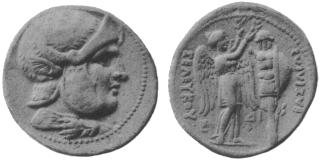
FIG. 332.



[P. Gardner, Brit. Mus. Cat., Seleucid Kings of Syria, 1879. Sir E. Bunbury, Unpublished Coins of the Kings of Syria in Num. Chron., 1883, pp. 65 ff. E. Babelon, Les Rois de Syrie, &c. (Paris Coll.), 1890. F. Imhoof-Blumer, Die Münzstätte Babylon, &c., in Num. Zeit., 1895, pp. 1 ff. G. Macdonald, Hunter Cat., Vol. iii, 1905, pp. 5-117, and Early Seleucid Portraits in Journ. Hellen. Stud., 1903, pp. 92 ff., and 1907, pp. 145 ff.]
Owing to the similarity of names and to the extreme difficulty of distinguishing some of the portraits, the long and interesting series of the coins of the kings of Syria is still in part but imperfectly classified. Not until the reign of Antiochus IV (Epiphanes), when titles begin to be employed, are we on firm ground historically.[1] In particular, the attri- bution of much of the early Æ remains highly conjectural.
Seleucus I (Nicator), B.C. 312-280, was the founder of the dynasty. He had been one of Alexander’s principal officers, and was appointed satrap of Babylon by the regent Antipater in B.C. 321. Expelled by
1 Even in the later period confusion is caused by some kings continuing to use obverse dies bearing the portraits of their predecessors.
For anonymous coins attributed to Seleucus as satrap see under Babylon (infra, p. 816). Prior to B.C. 306 his currency consisted largely of AV and AR with the name and types of Alexander, his issues being some- times distinguished by an anchor as adjunct symbol (Müller, Nos. 1355-9 and 1491-1514). The following remarkable pieces, with Ptolemaic obverse, seem to be connected with his stay in Egypt :—AV Double- staters, anonymous, obv. Head of Alexander in elephant-skin, and rev. Nike, with head of horned horse in the field; Æ. ΑΛΕΞΑΝΔΡΟΥ, Similar types or, sometimes, rev. Anchor (Svoronos, Νομ. των Πτολ., Pl. I. 29-35). The corresponding AR bore Alexander’s name and types (Müller, No. 1487). Alexandrine types continued to be employed by Seleucus for various denominations, including the obol (N. C., 1900, p. 293), down to the very end of his reign; tetradrachms minted at Pergamum cannot be earlier than circ. B.C. 284 (Imhoof, Dyn. von Pergamon, pp. 15 f.). But after B.C. 306 his own name, generally accompanied by ΒΑΣΙΛΕΩΣ, was usually (though not invariably) sub- stituted for that of Alexander. Other innovations appeared. On a good many specimens Zeus holds Nike instead of eagle, while on the Dr. and ½ Dr. of one series the figure of Seleucus, wearing horned helmet and mounted on horned horse, replaces the seated Zeus (N. Z., 1895, p. 15). This tendency to modification found more decided expression in completely new types, the Attic weight of Alexander's coinage being maintained. All have inscr. ΒΑΣΙΛΕΩΣ ΣΕΛΕΥΚΟΥ. The following were probably the earliest :—
| Head of Apollo. [N. Z., 1895, Pl. II. 6, and 1901, Pl. I. 1.] | Artemis shooting, in car drawn by two
horned elephants. AV Stater
|
| Head of Zeus. [B. M. C., Pl. I. 8.] | Athena fighting, in similar car.
AR Tetradr., Dr., ½ Dr., and Obol
|
| Id. [B. M. C., Pl. I. 7.] | Similar; car has four horned elephants.
AR Tetradr. and Dr.
|
| Head of Athena. [Imhoof, Zur gr. und röm. Münzkunde, Pl. VIII. 21.] | Head of elephant.
AR Drachm [Vienna] and Obol
|
Most of the preceding have symbols, monograms, or letters on the rev. They fall naturally into groups, indicating that they were struck over
| Head of Seleucus, with bull’s horn. [B. M. C., Pl. I. 6.] | Head of bridled horse, with horns and
plume. AV Stater and AR Tetradr.
|
In all likelihood the types just described were introduced towards the close of the reign of Seleucus; his successor adopted them. On the other hand, a series with rev. recalling the coinage of Agathocles (p. 181) may have begun after the victory of Ipsus (B.C. 301) :—

| Head of Seleucus, idealized, in helmet ornamented with bull’s horn and covered with panther’s skin. | Nike crowning trophy (Fig. 332).
AR Tetradr., Dr., and ½ Dr.
|
| Id. [Philipsen Coll.] | Id., without ΒΑΣΙΛΕΩΣ. AR Obol
|
The foregoing, which are not distinctively Eastern, seem to represent the Syrian mintage of Seleucus after the transference of his capital to Antioch (cf. N. Z., 1895, p. 17). At the same time they must have been well known beyond the Euphrates, for barbarous imitations come from Baluchistan (see infra under Antiochus I). The remaining AR of Seleucus may have been struck in Central Asia, the head of the horned horse being particularly associated with the East:—
| Head of bridled horse, with horns. [Babelon, Rois, Pl. II. 9.] | Elephant walking. AR Tetradrachm
|
| Id. [B. M. C., Pl. II. 1.] | Anchor. AR Drachm
|
| Id. [Babelon, Rois, Pl. II. 11.] | Bow and quiver. AR Diobol
|
| Tripod. [B. M. C., Pl. II. 2.] | Anchor. AR Obol
|
| Id. [Berlin.] | Bow and quiver. AR Obol
|
The Æ coins are numerous and varied; for details see London, Paris, and Hunter Catalogues. Some of the types resemble those of the AR, but the array of obverses with facing heads is remarkable.
Antiochus I (Soter), called βασιλευς in the cuneiform inscriptions of Babylon at least as early as B.C. 289, was associated with his father in the government circ. B.C. 293-281, the provinces beyond the Euphrates being committed to his care. To this period doubtless belong the AR coins with ΒΑΣΙΛΕΩΣ ΣΕΛΕΥΚΟΥ ΑΝΤΙΟΧΟΥ. ‘Antiochus, son of
It is quite possible that among the many coins inscribed ΒΑΣΙΛΕΩΣ ΑΝΤΙΟΧΟΥ there may be some that were issued by Antiochus I as viceroy of the East; this is notably so with those that have his father's head on the obv. The great majority must, however, have been struck during his own tenure of the supreme power, B.C. 281-261. All are of Attic weight. Alexandrine types are found both on AV (Hunter Cat., iii, Pl. LXIII. 21) and on AR (tetradrachms, drachms, and hemidrachms). Nor were the characteristic types of Seleucus abandoned, all the coins on which these appear being seemingly of Central Asian origin [2]:—
| Head of Seleucus I, with bull’s horn. [Hunter Cat., iii. Pl. LXIII. 20.] |
Head of horned horse. AR Tetradr.
|
| Head of Antiochus I. [B. M. C., Pl. XXVIII. 15.] |
Id. AV Stater, AR Tetradr., Dr., ½ Dr.,
and Obol [Petrowicz Coll.]
|
| Helmeted head: barbarous. [N. C., 1904, Pl. XVII. 1-7.] |
Nike crowning trophy: barbarous.
AR Dr., ½ Dr., and Obol
|
After his death Antiochus I was deified as ‘Αντιοχος ‘Απολλων Σωτηρ (C. I. G., 4458), a circumstance that throws some light on the most noteworthy type he introduced—Apollo on the omphalos.
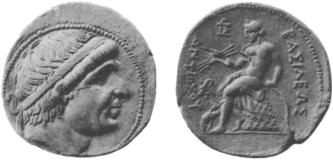
| Head of Seleucus I, with bull’s horn. [N. C., 1883, Pl. IV. 1.] | Apollo, naked, seated on omphalos, look-
ing along bow. AR Tetradr.
|
| Head of Antiochus I (cf. Fig. 333). | Similar; but Apollo looks along arrow.
AV Stater, AR Tetradr. and Dr.
|
The latter variety of rev. is the one which became conventional, but sometimes Apollo holds two or three arrows, as he does on Fig. 333. Differences of style and fabric prove that coins with this rev. were minted at various widely separated centres. But it is remarkable that
1 The average weight of seven tetradrachms is 212.5 grs., the maximum 214.5.
2 The barbarous imitations of Fig. 332 come from Baluchistan (N. C., 1904, pp. 317 f.).
| Head of Antiochus I. [J. H. S., xxvii. Pl. XIII. 5.] |
Herakles seated on rock; in field, one-
handled vase. AR Tetradr.
|
The Æ coinage of Antiochus I, like that of his father, presents many varieties; see London and Paris Catalogues, and, regarding the denominations, Hunter Cat., iii. p. 15.
Seleucus, son of Antiochus I, appears as βασιλευς in the cuneiform inscriptions of Babylon from B.C. 275 to 269, when he held the vice- royalty of the East. No coins can be identified with certainty as his; see, however, J. H. S., xxiii. p. 110.
Antiochus II (Theos) ruled jointly with Antiochus I, circ. B.C. 266- 261; alone, B.C. 261-246. Inscr., ΒΑΣΙΛΕΩΣ ΑΝΤΙΟΧΟΥ. Wt., Attic. A head formerly supposed to be that of Antiochus Hierax or of Antiochus III is apparently that of Antiochus II (J. H. S., xxiii. Pl. I. 3 and 5). Characteristic likenesses, whose identity is absolutely certain, occur also on the better executed among the following, all struck about the beginning of the reign at Cyme, Myrina, or Phocaea (J. H. S., xxvii. pp. 145 ff.):—
| Head of Antiochus II. [Op. cit., Pl. XIII. 7-14, and Pl. XIV. 4-13.] | Herakles seated on rock; mint-marks.
AR Tetradrachm
|
Other varieties of portrait attach themselves more or less closely to those already mentioned, while others again have become associated with Antiochus II simply because they obviously do not represent either his father or his grandson. A remarkable AV stater has: obv. Head of Antiochus II, rev. Athena Nikephoros (Babelon, Rois, Pl. VI. 1). But the usual types are :—
| Head of Antiochus II. [B. M. C., Pl. V. 1 ff.] |
Apollo seated on omphalos.
AV Stater, AR Tetradr., and Dr.
|
Regarding the variations of this rev. see Babelon, Rois, p. lxii. On one set of tetradrachms (J. H. S., xxiii. Pls. I and II), struck chiefly at Alexandreia Troas, the king’s diadem is winged, a peculiarity which is local, not personal (op. cit., p. 102). On the majority of these, as well as on a certain number of other specimens, the head itself is idealized, perhaps an indication that they were struck after Antiochus was dead; see infra under Antiochus Hierax. All such pieces seem to have been minted in Western Asia Minor (op. cit., p. 116). On the other hand, the
| Head of Antiochus II. [N. C., 1881, Pl. II. 5-7.] |
Head of bridled horse, with horns and
plume. AV Stater, AR Tetradr. and Dr.
|
During the reign of Antiochus II Bactria, under Diodotus, revolted against Seleucid rule. Before the revolt the vassal may have placed his own portrait on the obv. of certain AV and AR coins with rev. ΒΑΣΙΛΕΩΣ ΑΝΤΙΟΧΟΥ, Zeus hurling fulmen (B. M. C., Pl. V. 7). At all events, portrait and type are identical with those that afterwards appear on the independent money of Diodotus. For Æ of Antiochus II see Hunter Cat., iii. pp. 22 f.
Seleucus II (Callinicus, Pogon), B.C. 246-226. Inscr., ΒΑΣΙΛΕΩΣ ΣΕΛΕΥΚΟΥ. Wt., Attic.
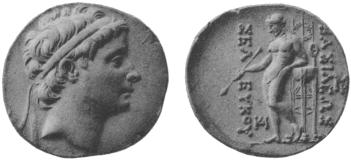
| Head of Seleucus II, sometimes with
slight whisker. [Hunter Cat., iii. Pl. LXIV. 18.] |
Apollo, naked, standing leaning on bow.
AV Stater, AR Dr., and Æ
|
| Head of Athena, in close helmet. | Id. [B. M. C., Pl. VI. 6]. AR Dr. and Æ
|
| Head of Seleucus II, rarely with slight whisker. (Fig. 334.) | Apollo, naked, standing leaning on
tripod. AR Tetradr., Dr., and Æ
|
| Head of Seleucus II, bearded (Πωγων, cf. Polybius, ii. 71). | Id. [N. C., 1886, Pl. XI. 18, and B. M. C.,
Pl. VI. 14]. AR Tetradrachm
|
The exceptional attitude here assumed by Apollo may be due to the conventional type having been usurped by Hierax (Six, N. C., 1898, p. 235). For other varieties, particularly of Æ, see Imhoof, Monn. gr., pp. 426 f., and also London, Paris, and Hunter Catalogues.
Antiochus Hierax, B.C. 246-227, revolted from his brother Seleucus II, and declared himself king of Asia Minor. It is probable that some of the tetradrachms with rev. Apollo on omphalos, and inscr. ΒΑΣΙΛΕΩΣ ΑΝΤΙΟΧΟΥ, were really issued by him. The probability is strongest in the case of those that bear an idealized head of his father, Antiochus II, and the mint-marks of cities like Alexandreia Troas, Cyzicus, Lampsacus, and Abydus (J. H. S., xxiii. p. 116). Various attempts to identify his own portrait have also been made (Bunbury, N. C., 1883, p. 83; Babelon, Rois, p. lxxii; Macdonald, J. H. S., xxiii. p. 114).
Seleucus III (Soter, Keraunos), B.C. 226-223, eldest son of Seleucus II. Inscr., ΒΑΣΙΛΕΩΣ ΣΕΛΕΥΚΟΥ. Wt., Attic.
| Head of Seleucus III, with slight whisker. [B. M. C., Pl. VII. 6 f.] | Apollo on omphalos, sometimes with l.
elbow on tripod.
AR Tetradr., Dr., and Æ
|
Other varieties of Æ are more doubtfully assigned to this king.
Antiochus III (the Great). B.C. 223-187, second son of Seleucus II, regained much of the territory that his predecessors had lost. Owing to the extent of his dominions and the length of his reign, his coins exhibit great differences in style and fabric. Inscr., ΒΑΣΙΛΕΩΣ ΑΝΤΙΟΧΟΥ. Wt., Attic. The usual rev. type is the traditional one :—
| Head of Antiochus III, rarely with
slight whisker. [Hunter Cat., iii. Pl. LXV. 6.] |
Apollo on omphalos.
AV Octadr., Stater, AR Tetradr., Dr.
|
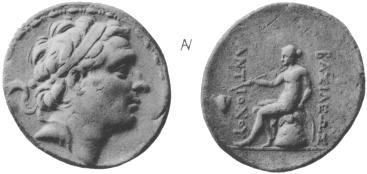
The AV octadrachms (Fig. 335), which weigh 528.5 grs. max., were issued at two distinct periods (Hunter Cat., iii. p. 30). A standard portrait is furnished by dated Æ struck in Phoenicia. Many varieties, however, occur on the AR, and identity is sometimes doubtful. On the coins of one well-marked group (cf. Fig. 335) one end of the diadem usually falls forward over the shoulder, while the obv. has a fillet- border. These are probably Syrian (Hunter Cat., iii. p. 31). Others, which show the king with thin, sharp features and elongated neck, are generally classed as Bactrian (N. C., 1883, p. 93, Pl. V. 8 f.). A minority appear to be certainly of Asia Minor (B. M. C., Pl. VIII. 6) or of Phoenicia (Babelon, Rois, Nos. 344 f.). On the following, which are much less common, the portrait sometimes approximates to the ‘Bactrian’ model :—
| Head of Antiochus III. [Babelon, Rois, Pl. X. 1-3.] |
Elephant.
AV Stater, AR Tetradr. and Dr.
|
The types of the Æ are very varied (Babelon, Rois, Pls. X and XI), and the serrated edge is now first met with. Some numismatists recognize the head of Antiochus III on coins struck at various European mints (B. M. C., Pl. XXVIII. 2-4; Babelon, Rois, pp. lxxxii f.).
Molon, B.C. 221-220, satrap of Media, revolted from Antiochus and struck Æ with inscr., ΒΑΣΙΛΕΩΣ ΜΟΛΩΝΟΣ.
| Head of Zeus. [B. M. C., Pl. X. 1.] | Apollo Musegetes. Æ .85
|
| Head of Apollo. [B. M. C., Pl. X. 2.] | Nike, crowning name of Molon. Æ .75
|
| Head of Achaeus. [Munich: Imhoof, Porträtköpfe, Pl. III. 19.] | Athena Promachos; in field, head of
horse. AV Stater
|
| Id. (?). [Babelon, Rois, p. lxxxviii.] | Apollo standing, with arrow. Æ .65
|
| Head of Apollo. [B. M. C., Pl. X. 3.] | Eagle, with palm or wreath. Æ .75
|
| Id. [B. M. C., Pl. X. 4.] | Tripod. Æ .45
|
| Id. [Babelon, Rois, Pl. XI. 12.] | Head of horse. Æ .4
|
Seleucus IV (Philopator), B.C. 187-175. Inscr, ΒΑΣΙΛΕΩΣ ΣΕΛΕΥΚΟΥ. Wt., Attic. The AR coins of this king are tetradrachms and drachms, with rev. Apollo on omphalos. The former fall into two groups, a large one with fillet-border on obv., and a much smaller one with border of dots. Here again, as in the case of his father, a standard portrait is furnished by dated Æ coins of Phoenicia. The ordinary rev. of these is the stern of a galley (Hunter Cat., iii. Pl. LXVI. 5), but one very rare variety has a lyre and the title ΦΙΛΟΠΑΤΟΡΟΣ. For Æ with serrated edges see Hunter Cat., iii. pp. 39 f. Cf. also Babelon, Rois, pp. xci and 64 ff.
Antiochus IV (Epiphanes), B.C. 175-164, a younger son of Antio- chus III, seized the throne upon his brother’s death. Inscr., ΒΑΣΙΛΕΩΣ ΑΝΤΙΟΧΟΥ, either alone or with ΘΕΟΥ (Babelon, Rois, Pl. XII. 5), ΕΠΙΦΑΝΟΥΣ, ΘΕΟΥ ΕΠΙΦΑΝΟΥΣ, ΕΠΙΦΑΝΟΥΣ ΝΙΚΗΦΟΡΟΥ, or ΘΕΟΥ ΕΠΙΦΑΝΟΥΣ ΝΙΚΗΦΟΡΟΥ. Wt., Attic. Few of the portraits of this king present a genuine likeness; see Babelon, Rois, p. xciii. For the most part the head is idealized as befits a ‘god incarnate’. The occa- sional appearance of a star above it on the tetradrachms, or of twin stars at the ends of the diadem, also indicates deification, while the diadem itself is often radiate on the smaller AR and usually so on the Æ.[1] The predominance of the fillet-border is even more decided than it had been in the previous reign. Henceforward the border of dots hardly occurs on Seleucid tetradrachms, always excepting those of Phoenician weight, where it is never absent. The traditional Seleucid rev. seems to have been used throughout the reign, being found with all forms of inscr.:—
| Head of Antiochus IV. [B. M. C., Pl. XI. 1-5.] |
Apollo on omphalos.
AR Tetradr., Dr., Æ
|
There are other types which never have the simple ΒΑΣΙΛΕΩΣ:—
| Head of Antiochus IV. [Babelon, Rois, Pl. XII. 9 f.] |
Zeus Nikephoros enthroned.
AV Stater, AR Tetradr., Æ
|
| Id. [Op. cit., Pl. XII. 7.] | Aegis (cf. Paus. v. 12. 4). AR ½ Dr., Æ
|
| Id. [B. M. C., Pl. XI. 6.] | Tripod-lebes. AR Diobol
|
Two rare varieties, both probably reproducing statues (cf. Babelon, Rois, pp. xciv ff.), are associated only with the longest inscr. :—
1 The radiate diadem also occurs on a very remarkable AR tetradrachm formerly in the O'Hagan Collection (Sale-Cat., Pl. XI, No. 663).
| Head of Zeus. [B. M. C., Pl. XI. 9.] | Zeus Nikephoros enthroned. AR Tetradr.
|
| Head of Apollo. [Babelon, Rois, Pl. XII. 12.] |
Apollo Musegetes. AR Tetradr.
|
A notable episode in the reign of Antiochus IV was his invasion of Egypt (B.C. 170-168). With this the following are evidently connected :— unique AR drachm (Hunter Cat., iii. Pl. LXVI. 19) and five denominations of Ptolemaic Æ (Svoronos, Νομ. των Πτολ., Pl. XLVIII. 1-5), all with rev. ΒΑΣΙΛΕΩΣ ΑΝΤΙΟΧΟΥ ΘΕΟΥ ΕΠΙΦΑΝΟΥΣ, Eagle on thunderbolt; also unique Æ with rev. ΒΑΣΙΛΕΩΣ ΑΝΤΙΟΧΟΥ, Two eagles on thunderbolt (op. cit., Pl. XLVIII. 7).[1] For details as to the ordinary Æ of Antiochus IV see London, Paris, and Hunter Catalogues. The occurrence of value-marks (= 1, 2, or 4 chalkoi) deserves mention; see Imhoof, Z. f. N., iii. pp. 347 ff. Occasion- ally the mint can be determined by the type. But the most remarkable feature is the inauguration of an extensive system of municipal coinage, with head of king on obv. and city-name on rev. It falls into two classes :— (α) With royal name: struck at Gebal (Byblus), Laodiceia in Canaan (Berytus), Sidon, Tyre, and Ascalon. The city-name is usually in Phoenician script, but sometimes in Greek and sometimes also in both. [B. M. C., Pl. XII. 14-16.] (β) Without royal name: struck at Aegeae, Alexandreia ad Issum, Antiocheia ad Sarum (Adana), Hieropolis, and Seleuceia ad Pyramum (Mopsus)—all in Cilicia; and also at Hieropolis in Cyrrhestica, Antiocheia ad Daphnen, Antiocheia in Ptolemais (Ace), Tripolis, Antiocheia ad Callirhoen (Edessa), Apameia in Syria, Laodiceia ad Mare, Seleuceia in Pieria, and Antiocheia in Mygdonia (Nisibis, infra, p. 815). [B. M. C., Pl. XIII. 1-8.] A coin of Tripolis has jugate heads of king and queen.
Antiochus V (Eupator), B.C. 164-162, had been made βασιλευς in 170 B.C., when his father set out for Egypt. He was then but three years old, and he may well be the child whose head appears on AR tetra- drachms with rev. ΒΑΣΙΛΕΩΣ ΑΝΤΙΟΧΟΥ, Apollo on omphalos (Six, N. C., 1897, pp. 215 f.; Macdonald, J. H. S., xxiii. p. 113). These were formerly attributed to a mythical son of Seleucus II, but seem certainly to belong to the early part of the second century B.C. The ordinary AR of Antiochus consists of Attic tetradrachms and drachms with inscr. ΒΑΣΙΛΕΩΣ ΑΝΤΙΟΧΟΥ ΕΥΠΑΤΟΡΟΣ. Rev. either Apollo on ompha- los, or Zeus seated (B. M. C., Pl. XIII. 11-14). For AV octadrachm with the latter type see Friedlaender and von Sallet, Das Königl. Münzkab., No. 426. The Berlin Museum likewise possesses a highly interesting AR tetradrachm with rev. ΒΑΣΙΛΕΩΣ ΑΝΤΙΟΧΟΥ ΕΥΠΑΤΟΡΟΣ, Ptolemaic eagle upon thunderbolt. Unfortunately it is plated, so that the standard cannot be determined. But in any event it forms an important link between the money struck by Antiochus IV in Egypt and the systematic issue of Seleucid coins on the Phoenician system, afterwards inaugurated by Alexander I (q. v.). The rare Æ of Antiochus V includes municipal of Gebal (Byblus) and of Tripolis.
1 Is it possible that the very rare AV staters of Antiochus IV form part of the spoils of Egypt? Polybius (xxviii. 17) records that the king presented ‘a gold piece’ to each of the Greek inhabitants of Naucratis.
Demetrius I (Soter), B.C. 162-150, was the son of Seleucus IV. Inscr., ΒΑΣΙΛΕΩΣ ΔΗΜΗΤΡΙΟΥ, either alone or with ΣΩΤΗΡΟΣ. AR tetra- drachms, drachms, diobols, and obols have rev. Apollo on omphalos (B. M. C., Pl. XIV. 3 and 5). But novel types are more common:—
| Head of Demetrius I. [B. M. C., Pl. XIV. 1 f.; cf. Imhoof, Monn. gr., p. 432.] | Tyche enthroned, holding sceptre and
cornucopiae. AR Tetradr., Dr.
|
| Id. [B. M. C., Pl. XIV. 4.] | Cornucopiae. AR Drachm
|
There are other changes. The fillet-border on the obv. is often replaced by a laurel-wreath, while dates (hitherto confined to Phoenician Æ) become frequent. The monograms on the rev. also lend themselves more readily to interpretation as mint-marks, although some of the attribu- tions made on this basis are doubtful. Barbarous imitations of the drachm with rev. Cornucopiae are fairly numerous. The weight of the AR is Attic, but there are very rare AV coins (Babelon, Rois, p. cxx, Pl. XVII. 1), with obv. Tyche enthroned and rev. Ptolemaic double cornucopiae, struck on a different standard, perhaps the Phoenician. Besides municipal Æ of Tyre and of Sidon (B. M. C., Pl. XIV. 6-8), there are several varieties of ordinary Æ. Conspicuous among these are some with heads of animals (B. M. C., Pl. XIV. 12-15); the king was a mighty hunter (Polybius, xxxi. 22. 3).
Demetrius married his sister Laodice, widow of Perseus of Macedon, and the heads of king and queen appear jugate on AR tetradrachms with rev. Tyche enthroned (B. M. C., Pl. XV. 1 f.); also on Æ with rev. Nike (Babelon, Rois, Pl. XVII. 7).
Timarchus, B.C. 162, satrap of Babylon, declined to acknowledge Demetrius, and issued coins in his own name. Inscr., ΒΑΣΙΛΕΩΣ ΜΕΓΑΛΟΥ ΤΙΜΑΡΧΟΥ, an Oriental form of title, used at this time in Parthia and also by Eucratides of Bactria, from whose coins the types of the tetradrachm are borrowed (see infra, p. 839). Wt., Attic.
| Head of Timarchus. [Babelon, Rois, p. cxv.] |
Nike in galloping quadriga. AV Stater
|
| Helmeted bust. [E. F. Weber, Sale-Cat., Pl. LIII, No. 4078.] | The Dioskuri charging. AR Tetradr.
|
| Head of Timarchus. [B. M. C., Pl. XXVIII. 6.] | Artemis, with bow and arrow.
AR Drachm
|
| Id. [B. M. C., Pl. XV. 3.] | Nike, with wreath and palm. Æ 1.35
|
Alexander I (Bala), B.C. 150-145, was a usurper who professed to be the son of Antiochus IV. Inscr., ΒΑΣΙΛΕΩΣ ΑΛΕΞΑΝΔΡΟΥ, either alone or with ΘΕΟΠΑΤΟΡΟΣ ΕΥΕΡΓΕΤΟΥ, ΕΥΠΑΤΟΡΟΣ (Hunter Cat. iii. p. 61, note), or ΕΠΙΦΑΝΟΥΣ ΝΙΚΗΦΟΡΟΥ (Babelon, Rois, Pl. XVIII. 8), all reminiscent of his pretended parentage. One series is very com- plete :—
| Head of Alexander I. [Babelon, Rois, Pl. XVII. 9 f.] |
Zeus Nikephoros enthroned.
AV Stater, AR Tetradr.
|
| Id. [B. M. C., Pl. XVI. 2.] | Apollo on omphalos. AR Drachm
|
| Id., radiate. [B. M. C., Pl. XVI. 3.] | Apollo standing. AR ½ Dr.
|
| Id.; no rays. [Babelon, Rois, Pl. XVII. 13.] |
Tripod. AR Diobol
|
| Head of Alexander I. [B. M. C., Pl. XV. 6.] |
Zeus enthroned, holding fulmen (Sidon).
AR Tetradr.
|
| Id. [B. M. C., Pl. XV. 5.] | Athena Nikephoros standing.
AR Tetradr.
|
| Id. [Babelon, Rois, Pl. XVII. 8.] | Tyche Nikephoros seated. AR Tetradr.
|
| Id. [Imhoof, Monn. gr., p. 433.] | Sandan on lion (Tarsus). AR Drachm
|
| Head of Zeus. [B. M. C., Pl. XVI. 1.] | Thunderbolt within wreath (Seleuceia in
Pieria). AR Tetradr.
|
Many of the preceding are dated. All are of Attic weight. But the reign of Alexander witnessed a fresh departure—the systematic striking,
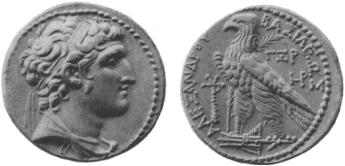
For details as to the abundant and varied Æ of Alexander I see London, Paris, and Hunter Catalogues. Many pieces have the serrated edge. A few are dated, and some have value-marks. Of special interest is the revival of the municipal coinage inaugurated by Antiochus IV (q. v.). Thus, coins of class (α) were struck at Berytus, Gebal (Byblus),
1 Coincidences of date and mint-mark in this and subsequent reigns show they were not intended to supersede the AR of Attic weight. Both kinds of money were issued simultaneously at the same cities. Except on the coins of Tryphon (q.v.) the dates are reckoned from the Seleucid era.
2 That the title was nevertheless meant to be read first is clear from the coins of Cleopatra and Antiochus VIII, and also from those of Tryphon.
Demetrius II (Nicator), B.C. 146-140 (first reign), son of Demetrius I, seized the kingdom with the aid of Ptolemy, who had quarrelled with Alexander and who now transferred Cleopatra to the new ruler. Inscr., ΒΑΣΙΛΕΩΣ ΔΗΜΗΤΡΙΟΥ, either alone or with ΝΙΚΑΤΟΡΟΣ, ΘΕΟΥ ΝΙΚΑΤΟΡΟΣ, ΦΙΛΑΔΕΛΦΟΥ ΝΙΚΑΤΟΡΟΣ, ΘΕΟΥ ΦΙΛΑΔΕΛΦΟΥ, or ΘΕΟΥ ΦΙΛΑΔΕΛΦΟΥ ΝΙΚΑΤΟΡΟΣ. For AV double-stater of Phoeni- cian weight, rev. Anchor, said to be of Persian provenance, see Walcher de Molthein, Cat., Pl. XXVII, No. 2979. AR of Phoenician weight, rev. Eagle, were struck at Berytus, Sidon, and Tyre. The types of the Attic AR are very various. The following apparently form a series :—
| Head of Demetrius II. [B. M. C., Pl. XVII. 8, 11.] |
Apollo on omphalos.
AR Tetradr., Dr., Obol
|
| Id. [Imhoof, Monn. gr., p. 435.] | Apollo standing. AR ½ Dr.
|
| Id. [Babelon, Rois, Pl. XIX. 5.] | Ear of corn on stalk. AR Diobol
|
A very rare variety of the tetradrachm (Babelon, Rois, Pl. XIX. 16) has a laurel-wreath in place of the usual fillet-border on the obv., a reminis- cence of the coinage of Demetrius I (q. v.). This is also recalled by the rare tetradrachm with rev. Tyche enthroned (B. M. C., Pl. XVIII. 2), to which belongs a drachm with rev. Zeus enthroned (ibid., 3). Other rev. types are—on tetradrachms (ibid., 1, 11, and 12): Athena Magarsis (Mallus), Zeus Nikephoros enthroned, Athena Nikephoros standing; and on drachms (Babelon, Rois, Pl. XIX. 4 and 6): Cornucopiae and Anchor. The Æ coins (not always easily distinguished from those of the second reign) are numerous, and include municipal of Berytus and of Tyre; see London and Hunter Catalogues.
The footing of Demetrius had never been other than precarious. Ulti- mately he withdrew to Babylon, and was made prisoner in a war with the Parthians.
Antiochus VI (Dionysos), B.C. 145-142, son of Alexander I, was set upon the throne, when a child of seven, by Tryphon, his father’s minister. Inscr., ΒΑΣΙΛΕΩΣ ΑΝΤΙΟΧΟΥ, seldom with ΕΠΙΦΑΝΟΥΣ, usually with ΕΠΙΦΑΝΟΥΣ ΔΙΟΝΥΣΟΥ. Wt., Attic. There are very rare AR tetra- drachms of B.C. 145 with rev. Zeus Nikephoros enthroned (Babelon, Rois, Pl. XX. 6). But his ordinary issues do not begin until the next year, when he assumed the title Διονυσος :—
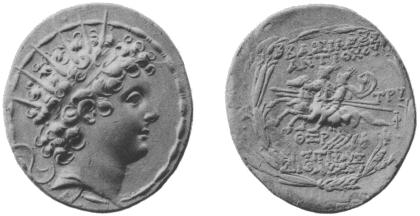
| Head of Antiochus VI, radiate (Fig. 337). | The Dioskuri, within wreath; dates.
AR Tetradr.
|
| Id. [B. M. C., Pl. XIX. 7.] | Helmet with ibex-horn; no dates.
AR Dr.
|
| Id. [B. M. C., Pl. XIX. 3.] | Apollo on omphalos; dates. AR Dr.
|
| Id. [B. M. C., Pl. XIX. 4.] | Apollo standing. AR ½ Dr.[1]
|
| Id. [B. M. C., Pl. XIX. 5.] | Panther. AR ½ Dr.
|
| Id. [B. M. C., Pl. XIX. 6.] | Thyrsos. AR Diobol
|
The use of the wreath on the rev. of these tetradrachms is an early example of a practice that subsequently became common. They all bear the letters ΤΡΥ, which also appear regularly on the undated drachms. During B.C. 144 ΤΡΥ, which obviously represents Tryphon, is accompanied only by single letters and monograms, which are apparently mint-marks. Thereafter ΣΤΑ is added beneath ΤΡΥ on the larger denomination. Simultaneously it begins to be placed on the dated drachms (on which ΤΡΥ never occurs), while it is also very prominent on the smaller AR with Dionysiac types (undated) and on the Æ. But there are tetradrachms of B.C. 142 struck from a die from which this name has been erased (Regling, Z. f. N., xxiv. p. 135). The inference is that ΣΤΑ was an important minister who fell from power abruptly. For Æ, often with Dionysiac types, see Hunter Cat., iii. pp. 74 ff.
Tryphon (Diodotus), B.C. 142-139, killed his ward and declared himself βασιλευς αυτοκρατωρ, a remarkable title, the importance of which is shown by the fact that it is written in full on the Phoenician AR (see supra, p. 765). Tryphon’s abandonment of the Seleucid era for dates is also significant. His best-known coins are AR Attic tetradrachms and drachms, and Æ, all having rev. Helmet with ibex-horn (B. M. C., Pl. XX. 1-3). AR Phoenician tetradrachms were struck at Byblus, Ptolemais, and Ascalon: rev. Eagle, with regnal dates (Babelon, Rois, Pl. XXI. 4 f.). There are also Æ of Ascalon (ibid., 6). Inscr., always ΒΑΣΙΛΕΩΣ ΤΡΥΦΩΝΟΣ ΑΥΤΟΚΡΑΤΟΡΟΣ.
Antiochus VII (Sidetes), B.C. 138-129, younger brother of Demetrius, overthrew Tryphon and married Cleopatra. Inscr., ΒΑΣΙΛΕΩΣ ΑΝΤΙΟ- ΧΟΥ, either alone or with ΕΥΕΡΓΕΤΟΥ. Phoenician AR was struck at Sidon and at Tyre (B. M. C., Pl. XX. 4); rev. Eagle. The types of the Attic AR are as follows :—
| Head of Antiochus VII. [B. M. C., Pl. XX. 6.] |
Athena Nikephoros standing (Tyre, &c.)
AR Tetradr.
|
| Id. [B. M. C., Pl. XX. 7.] | Nike (Tyre, &c.). AR Drachm
|
| Id. [B. M. C., Pl. XXVIII. 8.] | Pyre of Sandan (Tarsus). AR Tetradr.
|
| Id. [Hirsch, Auct. Cat. xiii, No. 4467.] | Sandan on lion (Tarsus). AR Drachm
|
| Id. [Petrowicz Coll.] | Athena Magarsis (Mallus). AR Drachm
|
| Id. [Brit. Mus.] | Tyche seated. AR Drachm
|
The Æ is interesting and includes some new types, e.g. obv. Bust of Eros and rev. Head-dress of Isis, as well as municipal of Seleuceia in
1 These hemidrachms read simply ΒΑΣΙΛΕΩΣ ΑΝΤΙΟΧΟΥ.
Demetrius II (Nicator), B.C. 129-125 (second reign), was liberated by the Parthian king in order to make trouble for Antiochus. Inscr., ΒΑΣΙΛΕΩΣ ΔΗΜΗΤΡΙΟΥ, either alone or with ΝΙΚΑΤΟΡΟΣ, ΘΕΟΥ ΝΙΚΑΤΟΡΟΣ, or ΘΕΟΥ ΦΙΛΑΔΕΛΦΟΥ ΝΙΚΑΤΟΡΟΣ. Phoenician AR, rev. Eagle, was struck at Ptolemais, Sidon, and Tyre. The Attic AR was of several varieties :—
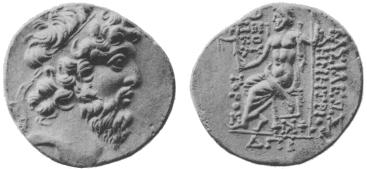
| Head of Demetrius II, bearded. | Zeus Nikephoros enthroned (Fig. 338)
AR Tetradr., Drachm
|
| Id. [B. M. C., Pl. XXI. 5.] | Athena Magarsis (Mallus). AR Drachm
|
| Id. [B. M. C., Pl. XXI. 6.] | Pyre of Sandan (Tarsus). AR Tetradr.
|
| Id. [B. M. C., Pl. XXI. 7.] | Sandan on lion (Tarsus). AR Drachm
|
| Id. [Berlin.] | Thunderbolt within wreath (Seleuceia
in Pieria). AR ½ Dr.
|
With rare exceptions (N. C., 1883, Pl. VI. 7) the coins of Phoenician weight retain the beardless portrait of Demetrius which they had borne during his first reign. On all others belonging to the second reign he is represented with a beard. If he began to grow his beard after his return, as is perhaps indicated by N. C., 1883, Pl. VI. 4, then the earliest of his new Attic tetradrachms had rev. Apollo on omphalos (Babelon, Rois, Pl. XIX. 15). But for the most part this once familiar type figures only on the Æ of his second reign: see Hunter Cat., iii. pp. 87 ff., where other types of Æ are recorded, the most interesting being that with a figure in Parthian dress (op. cit., Pl. LXVII. 22). There are municipal coins of Sidon and Tyre, the former without the royal name.
Alexander II (Zebina), B.C. 128-123, was set up by Ptolemy Physcon as a rival to Demetrius. Inscr., ΒΑΣΙΛΕΩΣ ΑΛΕΞΑΝΔΡΟΥ. On the unique AV stater in the British Museum, rev. Zeus Nikephoros enthroned, he adds ΘΕΟΥ ΕΠΙΦΑΝΟΥΣ ΝΙΚΗΦΟΡΟΥ, a reminder that he claimed to have been adopted by Alexander I, the pretended son of Epiphanes. This piece is perhaps to be connected with the king’s plundering of the golden Nike held by the statue of Zeus at Antioch (Wroth, N. C., 1897, p. 115 [citing Pl. V. 8]). Phoenician AR, rev. Eagle, was struck at Ascalon (Babelon, Rois, p. cl). But the great mass of the AR is Attic:—
| Head of Alexander II. [B. M. C., Pl. XXII. 2.] |
Zeus Nikephoros enthroned. AR Tetradr.
|
| Id. [B. M. C., Pl. XXII. 3.] | Double cornucopiae. AR Drachm
|
| Id. Hunter Cat., iii. Pl. LXIX. 9.] | Single cornucopiae. AR ½ Dr.
|
| Id. [B. M. C., Pl. XXII. 5.] | Nike. AR ½ Dr.
|
| Id. [Babelon, Rois, Pl. XXIII. 8.] | Anchor. AR Diobol
|
| Id. [B. M. C., Pl. XXII. 4.] | Athena Nikephoros standing.
AR Drachm
|
| Id. [Petrowicz Coll.] | Pyre of Sandan (Tarsus). AR Tetradr.
|
| Id. [Babelon, Rois, Pl. XXIII. 6.] | Sandan on lion (Tarsus). AR Drachm
|
The Æ includes municipal of Berytus (Babelon, Rois, Pl. XXIII. 17). For numerous ordinary varieties see Hunter Cat., iii. pp. 93 ff.
Cleopatra, B.C. 125-121, was successively the wife of Alexander Bala, of Demetrius Nicator, and of Antiochus Sidetes. The eldest of her sons by Demetrius assumed the diadem as Seleucus V upon his father’s death. His mother straightway had him murdered, and took the supreme power into her own hands. The British Museum possesses an AR tetradrachm of Attic weight, dated ΖΠΡ (= B.C. 125), and reading ΒΑΣΙΛΙΣΣΗΣ ΚΛΕΟΠΑΤΡΑΣ ΘΕΑΣ ΕΥΕΤΗΡΙΑΣ. The rev. type is Egyptian:—
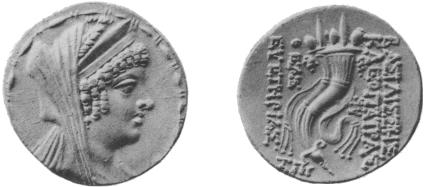
| Head of Cleopatra (Fig. 339). | Double cornucopiae, filleted. |
The queen soon associated with her in the government a younger son of Demetrius, Antiochus VIII (Grypus). Their jugate heads appear on Phoenician AR struck at Sidon: rev. ΒΑΣΙΛΙΣΣΗΣ ΚΛΕΟΠΑΤΡΑΣ ΒΑΣΙΛΕΩΣ ΑΝΤΙΟΧΟΥ, Eagle. Inscr. on their Attic AR, ΒΑΣΙΛΙΣΣΗΣ ΚΛΕΟΠΑΤΡΑΣ (ΘΕΑΣ) ΚΑΙ ΒΑΣΙΛΕΩΣ ΑΝΤΙΟΧΟΥ[1]:—
| Heads jugate of Cleopatra and An- tiochus VIII [B. M. C., Pl. XXIII. 3.] | Zeus Nikephoros enthroned (Sidon, &c.)
AR Tetradr.
|
| Id. [N. C., 1900, Pl. I. 14.] | Pyre of Sandan (Tarsus). AR Tetradr.
|
For Æ with the joint names see Hunter Cat., iii. pp. 97 ff.
Antiochus VIII (Grypus), B.C. 121-96, finally compelled his mother to drink poison which she had prepared for himself. His nickname is
1 ΘΕΑΣ is usually omitted on the Æ, and occasionally on the AR. A few of the tetradrachms have a border of dots, instead of a fillet-border, on the obv. The group so formed stands alone in the later coinage of the Seleucidae (see supra, p. 762).
| Head of Antiochus VIII [B. M. C., Pl. XXIV. 1.] | Zeus Ouranios standing (Sidon, &c.)
AR Tetradr.
|
| Id. [B. M. C., Pl. XXIV. 2.] | Athena Nikephoros standing (Seleuceia
ad Calycadnum, &c.). AR Tetradr.
|
| Id. [B. M. C., Pl. XXIV. 3.] | Pyre of Sandan (Tarsus). AR Tetradr.
|
| Id. [Babelon, Rois, Pl. XXV. 6.] | Sandan on lion (Tarsus). AR Drachm
|
| Id. [Petrowicz Coll.] | Tyche standing (Tripolis). AR Drachm
|
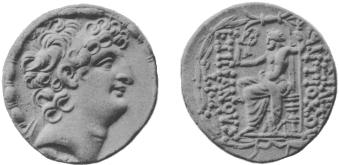
| Head of Antiochus VIII (Fig. 340). | Zeus Nikephoros enthroned. AR Tetradr.
|
| Id. [B. M. C., Pl. XXVI. 4.] | Tripod. AR Drachm
|
| Id. [B. M. C., Pl. XX. 8, and XXVI. 5.] | Nike. AR ½ Dr.
|
| Id. [Imhoof, Mon. gr., p. 436.] | Ear of corn on stalk. AR Diobol
|
The Æ coins are numerous, but none of the types are noteworthy. One group, however, is remarkable for the inscr. ΒΑΣΙΛΕΩΣ ΑΝΤΙΟ- ΧΟΥ ΦΙΛΟΜΗΤΟΡΟΣ (Hunter Cat., iii. p. 103). There are Æ of Sidon without the royal name (Babelon, Rois, Pl. XXIV. 16.).
Antiochus IX (Cyzicenus), B.C. 114-95, son of Antiochus VII and Cleopatra, after a struggle divided the kingdom with his half-brother Grypus (B.C. 111), taking as his share Coele-Syria and Phoenicia. His Phoenician AR, rev. ΒΑΣΙΛΕΩΣ ΑΝΤΙΟΧΟΥ, Eagle, is fairly common (Sidon, Ascalon, &c.). But he was the last Seleucid king to strike coins of this class. The title ΦΙΛΟΠΛΤΟΡΟΣ is used on his Attic AR, the obol having ΒΑ ΑΝ ΦΙ:—
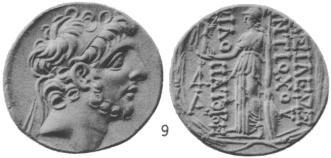
| Head of Antiochus IX (Fig. 341). | Athena Nikephoros standing (Sidon, &c.)
AR Tetradr.
|
| Id. [Babelon, Rois, Pl. XXVI. 11.] | Nike. AR ½ Dr.
|
| Id. [Petrowicz Coll.] | Ear of corn on stalk. AR Diobol
|
| Id. [Petrowicz Coll.] | Athena Nikephoros standing. AR Obol
|
| Id. [B. M. C., Pl. XXV. 1.] | Zeus Nikephoros enthroned. AR Tetradr.
|
| Id. [Babelon, Rois, Pl. XXVI. 5 f.] | Tyche standing (Tripolis). AR Tetr., Dr.
|
| Id. [Babelon, Rois, Pl. XXVI. 12.] | Pyre of Sandan (Tarsus). AR Tetradr.
|
| Id. [Ibid., 13.] | Sandan on lion (Tarsus). AR Drachm
|
For Æ of various types see London, Paris, and Hunter Catalogues.
Seleucus VI (Epiphanes Nicator), B.C. 96-95, succeeded his father Grypus, and renewed the war with Cyzicenus. Inscr., ΒΑΣΙΛΕΩΣ ΣΕΛΕΥΚΟΥ ΕΠΙΦΑΝΟΥΣ ΝΙΚΑΤΟΡΟΣ, with occasional omission of ΕΠΙΦΑΝΟΥΣ For Æ see Hunter Cat., iii. pp. 109 f. His AR coins (Attic weight) are:—
| Head of Seleucus VI. [B. M. C., Pl. XXVIII. 11.] |
Zeus Nikephoros enthroned. AR Tetradr.
|
| Id. [Babelon, Rois, Pl. XXVII. 3.] | Nike. AR Drachm
|
| Id. [B. M. C., Pl. XXV. 13.] | Double cornucopiae. AR ½ Dr.
|
| Id. Imhoof, Monn. gr., p. 437.] | Ear of corn on stalk. AR Diobol
|
| Id. [B. M. C., Pl. XXV. 12; cf. Im- hoof, Kl. M., ii. p. 482.] | Athena Nikephoros standing (Seleuceia
ad Calycadnum). AR Tetradr.
|
Antiochus X (Eusebes Philopator), B.C. 95-83, son of Cyzicenus, spent his reign in warfare first with Seleucus VI, and then with the other sons of Grypus. Inscr., ΒΑΣΙΛΕΩΣ ΑΝΤΙΟΧΟΥ ΕΥΣΕΒΟΥΣ ΦΙΛΟ- ΠΑΤΟΡΟΣ. Wt., Attic.
| Head of Antiochus X. [B. M. C., Pl. XXVI. 1.] |
Zeus Nikephoros enthroned. AR Tetradr.
|
| Id. [Hunter Cat., iii. Pl. LXX. 12.] | Tyche standing (Tripolis). AR Drachm
|
| Id. [Berlin.] | Nike standing. AR ½ Dr.
|
Antiochus XI (Philadelphus), B.C. 92, second or third son of Grypus, struck AR Attic tetradrachms with rev. Zeus Nikephoros enthroned; also Æ with rev. Athena Nikephoros standing: see Babelon, Rois, Pl. XXVII. 11 f. Inscr. ΒΑΣΙΛΕΩΣ ΑΝΤΙΟΧΟΥ ΕΠΙΦΑΝΟΥΣ ΦΙΛΑΔΕΛΦΟΥ, ΕΠΙ- ΦΑΝΟΥΣ being usually omitted on the AR. Other coins sometimes attri- buted to this king belong more probably to his father (op. cit., p. clxvii). But there are very rare tetradrachms (Attic) which show his head jugate with that of his brother Philippus: rev. ΒΑΣΙΛΕΩΣ ΑΝΤΙΟΧΟΥ ΚΑΙ ΒΑΣΙΛΕΩΣ ΦΙΛΙΠΠΟΥ, Zeus Nikephoros enthroned (op. cit., Pl. XXVII. 13).
Philippus (Philadelphus), B.C. 92-83, another son of Grypus, struck AR Attic tetradrachms with rev. ΒΑΣΙΛΕΩΣ ΦΙΛΙΠΠΟΥ ΕΠΙΦΑΝΟΥΣ ΦΙΛΑΔΕΛΦΟΥ, Zeus Nikephoros enthroned (B. M. C., Pl. XXIV. 9). Some are dated from an era beginning in B.C. 111, when Grypus re- turned from exile in Aspendus, and divided the kingdom with Cyzicenus (cf. Wilcken, Hermes, xxix. pp. 436 ff.).
Demetrius III (Philopator), B.C. 95-88, fourth son of Grypus, also took the field against Antiochus X, and proclaimed himself king. Inscr., ΒΑΣΙΛΕΩΣ ΔΗΜΗΤΡΙΟΥ, with either ΘΕΟΥ ΦΙΛΟΠΑΤΟΡΟΣ ΣΩ- ΤΗΡΟΣ or ΦΙΛΟΜΗΤΟΡΟΣ ΕΥΕΡΓΕΤΟΥ ΚΑΛΛΙΝΙΚΟΥ. Wt., Attic.
| Head of Demetrius III. [Babelon, Rois, Pl. XXVIII. 4.] |
Zeus Nikephoros enthroned. AR Tetradr.
|
| Id. [B. M. C., Pl. XXVI. 10.] | Archaic simulacrum of Asiatic goddess,
facing. AR Tetradr.
|
The last type probably represents Atargatis (Dea Syra) of Damascus: see Rev. archëol., 1904, p. 250. This city was the capital of Demetrius. It seems to have temporarily borne the name of ‘Demetrias’ (Wroth, B. M. C., Galatia, pp. lxxv f.), and to have issued municipal Æ: obv. Head of Demetrius III, and rev. ΔΗΜΗΤΡΙΕΩΝ ΤΗΣ ΙΕΡΑΣ. For this and ordinary Æ see Hunter Cat., iii. pp. 114 f.
Antiochus XII (Dionysos), circ. B.C. 87-84, the youngest of the five sons of Grypus, aspired to succeed Demetrius III as king of Coele-Syria. His very rare AR Attic tetradrachms have rev. ΒΑΣΙΛΕΩΣ ΑΝΤΙΟΧΟΥ ΕΠΙΦΑΝΟΥΣ ΚΑΛΛΙΝΙΚΟΥ, Bearded divinity standing, facing, on a base between two recumbent bulls (N. Z., 1902, Pl. I. 3, 4). This is probably Hadad of Damascus (see Journ. Asiat., 1904, p. 200). Antio- chus, too, made Damascus his capital, and his head appears on muni- cipal Æ of ‘Demetrias’ (cf. Demetrius III, supra), for which, as well as for other varieties of Æ, see Hunter Cat., iii. pp. 115 ff.
Tigranes, B.C. 83-69, King of Armenia (B.C. 97-56), was invited to put an end to the internecine strife in Syria. This he did, and ruled the country peaceably till his defeat by Lucullus. His coins, Attic AR and Æ, fall into three classes (N. C., 1902, pp. 193 ff.):—
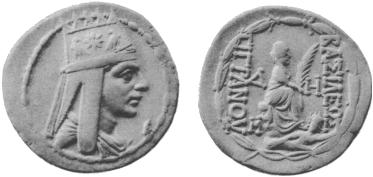
| Head of Tigranes, wearing lofty Arme- nian tiara (Fig. 342). | Tyche of Antioch seated; river-god
swimming at her feet. AR Tetradr.
|
| Id. [B. M. C., Pl. XXVII. 9; Babelon, Pl. XXIX. 13.] | Nike, or Palm. Æ .7-.6
|
| Head of Tigranes as above; less good work. [Babelon, Rois, Pl. XXIX. 15.] | Tyche with river-god, as above; less
good work. AR Tetradr., Dr.
|
| Id. [B. M. C., Pl. XXVII. 10 f.] | Id., or Herakles standing. Æ 1-.7
|
| Head of Tigranes as above; poor work. [B. M. C., Pl. XXVII. 5.] |
Tyche with river-god, as above, but l.;
poor work. AR Tetradr.
|
| Id. [B. M. C., Pl. XXVII. 7; Babelon, Pl. XXIX. 14.] | Id., or Tyche standing. Æ .9-.55
|
The rev. of Fig. 342 represents the famous statue of the Tyche of Antioch by Eutychides of Sicyon (Paus. vi. 2). The corresponding type on coins of class (iii) is rather the Tyche of Damascus; cf. the Imperial coins of that city and also those of Aretas III.
(β) Autonomous and Imperial of Syria, Phoenicia, etc.
[Wroth, B. M. C., Galatia, Cappadocia, Syria.
Babelon, Perses Achéménides.
De Saulcy, Numismatique de la Terre-Sainte.]
The coinage of the whole region between the Euphrates and the sea may be described by dividing it into districts in the order which Eckhel adopted:—
| I. Commagene. | VII. Trachonitis. |
| II. Cyrrhestica. | VIII. Decapolis. |
| III. Chalcidice. | IX. Phoenicia. |
| IV. Palmyrene. | X. Galilaea. |
| V. Seleucis and Pieria. | XI. Samaria. |
| VI. Coele-Syria. | XII. Judaea. |
Throughout the whole of this vast extent of territory, bounded on the north by offshoots of the Taurus, on the north-east by the Euphrates, and on the east and south by the deserts of Arabia, the royal gold coinage of Persia probably passed current down to the age of Alexander the Great. In the latter half of the fifth century the Persian gold coinage was supple- mented by the substantial silver money of the wealthy Phoenician cities of the sea-coast, governed for the most part by their own kings, who seem to have been more or less independent of the King of Persia. The coinage of these towns, Tyre, Sidon, and Byblus, inscribed with Phoenician characters, is regulated according to the standard, hence called Phoenician, of about 56 grs. to the drachm, or 224 grs. to the shekel. Aradus, on the other hand, the most northern town on the Phoenician coast, accommodated her money to the standard which prevailed in Cyprus and Cilicia, striking shekels of about 168 grs. equivalent to three-quarters of the Tyrian and Sidonian shekel.
On the Macedonian conquest all the old coinages, both Persian and Phoenician, were abolished, except at Tyre, and mints were set up by Alexander or his immediate successors at all the chief coast-towns of Phoenicia and Palestine, viz. Marathus, Aradus, Sidon, Tyre, Ace, Joppa, Ascalon, and Gaza, as well as at some of the chief cities of the interior. This Alexandrine coinage lasted down to about B.C. 266, when Ptolemy Philadelphus, who had obtained possession of Phoenicia, established mints of his own at the chief cities along the coasts of Palestine and
Samos, circ. B.C. 140-130 (?).
| Head of king, diademed and radiate. [Babelon, p. 217, Pl. XXX. 1.] |
ΒΑΣΙΛΕΩΣ ΣΑΜΟΥ ΘΕΟΣΕΒΟΥΣ
ΚΑΙ ΔΙΚΑΙΟΥ in ex. ΓΛ Nike ad-
vancing. [Hunter]. Æ .6
|
| Head of king in pointed head-dress. [Hunter Cat., Pl. LXX. 20.] |
Same inscription. Thyrsos between two
interlaced cornuacopiae. Æ .85
|
Mithradates I (Callinicus), circ. B.C. 96. Son of Samos.
| Head of king in pointed head-dress. [B. M. C., p. 104; Babelon, Pl. XXX. 2.] |
ΒΑCΙΛΕΩC ΜΙΘΡΑΔΑΤΟΥ ΚΑΛΛΙ-
ΝΙΚΟΥ Athena standing, holding
Nike. Æ .85
|
| Eagle with palm. [Babelon, p. 217, No. 4.] |
Same inscription. Caduceus. [Paris]
Æ .7
|
| Eagle with palm. [Babelon, p. 218, No. 5.] |
Same inscription. Palm. [Paris]. Æ .6
|
Mithradates Philhellen Philoromaios, circ. B.C. 92 (?). Son of Mith- radates I Callinicus (?).
| Head of king in pointed head-dress. | ΒΑΣΙΛΕΩ(ς) ΜΙΘΡΙΔ ΦΙΛΟ[ρω- μαιου ?]. Club. Æ Size .7. [Brit. Mus.; Berlin.] |
(On the attribution see Reinach, L'hist. par les monn., p. 244; the
Antiochus I (Theos), circ. B.C. 69-38 (or 31 ?). Son of Mithradates Callinicus by Laodice Thea Philadelphus, daughter of Antiochus VIII, Grypus, of Syria. Antiochus I struck the following bronze coin :—
| Bust of king in Armenian tiara on which star between two eagles (cf. tiara of Tigranes). | ΒΑΣΙΛΕΩΣ ΑΝΤΙΟΧΟΥ Lion walk-
ing. Æ .8
|
On a height of Mount Taurus, now the tumulus of Nemroud Dagh, Antiochus established a sacred precinct and royal mausoleum (B. M. C., p. xliv). On the Nemroud Dagh reliefs he wears an Armenian tiara ornamented with a lion. Another relief shows a star-spangled lion, Antiochus having been born under the zodiacal sign of the Lion.
The successor of Antiochus I was a king, probably his son, named Mithradates, circ. B.C. 31. Reinach (p. 245) supposes the following bronze at Berlin and Paris (Invent. Wadd., p. 447) to have been issued by Antiochus I and Mithradates in conjunction:—obv. [ΒΑΣΙΛΕΩΣ] ΑΝ- ΤΙΟΧΟΥ Bust of Antiochus in tiara, rev. ΜΙΘΡΑΔΑ[ΤΟΥ] Humped bull, rushing.
Two or three kings followed Mithradates in rapid succession. In B.C. 20 Augustus placed upon the throne another Mithradates,[1] who was succeeded by his son (or brother) Antiochus III. On the death of this Antiochus in A.D. 17, Commagene became a Roman province, but in 38 Caligula restored the kingdom for the benefit of his friend Antiochus IV, son of Antiochus III.
Antiochus IV of Commagene (Epiphanes), A.D. 38-72. Inscr., ΒΑΣΙΛΕΥΣ ΜΕΓ[ΑΣ] ΑΝΤΙΟΧΟΣ ΕΠΙΦΑ[ΝΗΣ]; ΒΑΣΙΛΕΥΣ ΜΕΓΑΣ ΑΝΤΙΟΧΟΣ; ΒΑ- ΣΙΛΕΥΣ ΑΝΤΙΟΧΟΣ.
| Head of king diademed. | ΚΟΜΜΑΓΗΝΩΝ Scorpion within
laurel-wreath. Æ 1.1
|
| Id. | ΚΟΜΜΑΓΗΝΩΝ Capricorn within
laurel-wreath. Æ .9
|
| Id. | ΚΟΜΜΑΓΗΝΩΝ Two cornuacopiae.
Æ .8
|
The Scorpion was the zodiacal sign under which Commagene stood. Cilicia formed part of the kingdom of this ruler, who issued money at Anemurium, Celenderis, Corycus, Sebaste, Lacanatis, and Cetis. He also struck coins in Lycaonia (B. M. C., p. xlvi, p. 108).
| ΒΑΙCΙΛΙCCΑ ΙΩΤΑΠΗ ΦΙΛΑΔΕΛ- ΦΟC Bust of Iotape. | ΚΟΜΜΑΓΗΝΩΝ Scorpion. Æ 1.15
|
1 Reinach (p. 246) attributes doubtfully to this king Æ inscribed ΒΑ(σιλεως) ΜΕ(γαλου) Μ(ιθραδατου) ΤΟΥ Μ(ιθραδατου); type, Crab; cf. Babelon, Rois de Syrie, p. ccxii.
Epiphanes and Callinicus, sons of Antiochus IV and Iotape, struck bronze coins in Commagene, Selinus, Lacanatis, and Lycaonia (B. M. C., p. xlviii).
| ΒΑCΙΛЄΩC ΥΙΟΙ Epiphanes and Cal- linicus on horseback. | ΚΟΜΜΑΓΗΝΩΝ Capricorn. Æ .8
|
| ΒΑCΙΛЄΩC ΥΙΟΙ Anchor between two crossed cornuacopiae, each containing a youthful head (Epiphanes and Cal- linicus). | „ Armenian tiara,
ornamented with scorpion: laurel-
wreath. Æ .8
|
| ΒΑCΙΛЄΥC ΜЄΓΑC ЄΠΙΦΑΝΗC Head of Epiphanes. CЄΛΙ (Selinus). | ΒΑCΙΛЄΥC ΜЄΓΑC ΚΑΛΛΙΝΙΚΟC
Head of Callinicus. Paris.
[Cf. B. M. C., p. xlvii.] Æ .9
|
Commagene in genere. Bronze coins of first century A.D. (? circ. A.D. 41, Rev. des études gr., 1899, p. 402), struck probably at Samosata (B. M. C., p. xlviii): Capricorn, rev. Scorpion. Capricorn, rev. ΚΟΜΜΑΓΗΝΩΝ Armenian tiara. ΠΙΣΤΙΣ, Two hands clasped holding caduceus, rev. ΚΟΜΜΑΓΗΝΩΝ, Anchor.
Antiocheia ad Euphratem (Pliny v. 24). Imperial of M. Aurelius and L. Verus, rev. ΑΝΤΙΟΧЄΩΝ ΠΡΟC ЄΥΦΡΑΤΗΝ, Bust of Athena (B. M. C., p. xlix).
Doliche (Duluk). Imperial of M. Aurelius, L. Verus, and Commodus, rev. ΔΟΛΙΧΑΙΩΝ within wreath.
Germanicia Caesareia (Marash). Imperial, M. Aurelius to Commodus. Inscr., ΚΑΙCΑΡ. ΓЄΡΜΑΝΙΚЄWΝ ΚΟ; ΚΑΙC. ΓЄΡΜΑ. ΚΟΜ. Types— City seated, with river-god swimming at her feet; Inscr. in laurel-wreath. (Contrast the coins of Caesareia Germanica in Bithynia.)
Samosata (Samsat), on the Euphrates, the capital of the kings of Com- magene. Autonomous bronze of the period of the Commagenian kings (Antiochus I-IV). Inscr., CΑΜΟCΑΤW; CΑΜΟCΑΤΩ ΠΟΛΕΩC. Types—Zeus; Lion; City seated on rock; Eagle. Imperial, Hadrian to Philip jun. Inscr., ΦΛΑ. CΑΜΟ. ΜΗΤΡΟ. ΚΟΜ. (i.e. Flavia Sa- mosata Metropolis Commagenes); Φ. CΑΜΟC. ΙЄΡ. ΑCΥ. ΑΥΤΟΝΟ. ΜΗΤΡ. ΚΟΜ.; CΑΜΟCΑΤЄΩΝ. Usual type—City seated; at her feet, river-god Euphrates or running Pegasos. Era dates from autumn of A.D. 71 (B. M. C., p. 117 n.).
Zeugma, on the right bank of the Euphrates, opposite Apameia (Birejik), both cities founded by Seleucus I and connected by a bridge of boats. Imperial, Trajan to Philip jun. Inscr., ΖЄΥΓΜΑΤЄΩΝ. Types—Tetrastyle temple with peribolos encircling the sacred grove (B. M. C., p. li), sometimes with capricorn in ex.; Inscr. in laurel-wreath.
Beroea, now Aleppo (Haleb). Imperial bronze with or without heads of Emperors, Trajan to Antoninus Pius. Rev. ΒЄΡΟΙΑΙWΝ within wreath. Also AR of Macrinus, rev. Eagle (Antioch type), ΒΕ and fantastic bird. (B. M. C., Galatia, &c., p. 132.)
Cyrrhus. Regal bronze of Alexander I, Bala, of Syria (q. v.). Inscr., ΚΥΡΡΗCΤΩΝ, rev. Zeus standing with wreath, also rev. Athena standing holding Nike (B. M. C., p. lii). Imperial, Trajan to Philip jun. Inscr., ΚΥΡΡΗCΤΩΝ, rev. ΔΙΟC ΚΑΤΑΙΒΑΤΟΥ (or ΚΑΤЄΒΑΤΟΥ), Zeus Katai- bates seated on rock holding his thunderbolt and sceptre, before him, eagle. Also Temple containing his statue. This Zeus had altars at Olympia, Athens, &c.; rocks and places struck by lightning were re- garded as sacred to him (B. M. C., p. lii). Also rev. Inscr. in laurel-wreath. On some later coins, symbol, ram.
Hieropolis (Membij). The ancient name Bambyce was changed to
Hieropolis by Seleucus Nicator, who built a new temple for Atargatis
(Astarte), the great goddess of the city (cf. the treatise De dea Syria).
The following Attic didrachms with Aramaic inscriptions have been
attributed (B. M. C., Galat., p. liii) to Bambyce :—(α) Coins of the
sacerdotal dynasty of Abd-Hadad, circ. B.C. 332: Bust of Atargatis, rev.
inscr., Abd-Hadad, King and driver in chariot; Bust of Atargatis
(with name inscribed), rev. Abd-Hadad, Abd-Hadad standing in temple.
(β) Coins with name ‘Alexander’ [the Great ?]. Types—Bust of Atar-
gatis, rev. Lion devouring bull; Bust of Atargatis facing, rev. King and
driver in chariot; Baal enthroned, rev. Atargatis riding on lion;
Warrior on horse, rev. Lion walking, in front, bird perched on flower.
In the second century B.C. there are bronze coins of Antiochus IV
of Syria (q. v.), rev. ΙЄΡΟΠΟΛΙΤΩΝ, Zeus standing holding wreath.
Quasi-autonomous and Imperial, Trajan to Philip jun. Inscr., ΙЄΡΟ-
ΠΟΛΙΤΩΝ. Types (often accompanied by ΘЄΑC CΥΡΙΑC)—Atargatis
riding on lion or enthroned between two lions; Temple, within which,
Roman standard, on one side of the temple, Baal Kevan seated between
two oxen, on the other, Atargatis seated between two lions, inscr., ΘЄΟΙ
CΥΡΙΑC (Imhoof, Gr. M., p. 759, No. 773, cf. No. 772). Also silver
(Antioch class) of Domna, Caracalla (symbol, lion), Macrinus (symbol, lion),
and Diadumenian. Also bronze of Imperial times dated from Seleucid
Era. The inscr. ΘЄΑC CΥΡΙΑC, which frequently appears within a laurel-
wreath and without any type, probably indicates the Festival in
connexion with which the coins bearing it were issued.
Chalcis (Kinnesrin), near Beroea (Aleppo). Imperial—Trajan to
L. Verus. Inscr., ΦΛ. ΧΑΛΚΙΔЄWΝ. Types—Laurel-wreath; Standing
figure radiate holding palm-branch, spear, and shield, with inscr. ΗΛΙΟ-
CЄΙΡΟC, Hunter Cat., Pl. LXXI. 27. Date ΚЄ (25) on coins of Trajan
and of Hadrian = A.D. 117, from era beginning A.D. 92.
Palmyra struck small bronze coins without the names or heads of
Emperors. These were probably issued from the first century A.D.
till the time of Sept. Severus and his family. Inscr., when present, ΠΑΛ-
ΜVΡΑ. Types—Palm-tree; Bearded male head in modius, radiate = the
Malach-belos of Palmyra (?); Female figure (Atargatis ?) on lion; Lion
and crescent; Head of Tyche of Palmyra; and other types described by
De Saulcy (see B. M. C., Galat., pp. lvi-lviii). For coins with the heads
of Zenobia and Vaballathus see infra, Egypt under the Romans.
Tetrapolis of Seleucis. The four cities of Antiocheia, Seleuceia,
Apameia, and Laodiceia, all founded by Seleucus I, used a joint bronze
coinage during part of the second century B.C., beginning B.C. 149.
Inscr., ΑΔΕΛΦΩΝ ΔΗΜΩΝ (cf. Strabo, xvi, p. 749 αιπερ και ελεγοντο
αλληλων αδελφαι δια την ομονοιαν). Types—Head of Zeus, rev. Fulmen;
Head of Apollo, rev. Tripod; Bearded heads (? Demoi of Antiocheia and
Seleuceia), rev. Tyche crowning the inscription, or rev. Zeus seated. Dates
according to the Seleucid Era. Mint, apparently Seleuceia (Hunter
Cat., iii. p. 141).
Antiocheia ad Orontem, on the right bank of the Orontes, about
twenty miles from its mouth, was the capital of the Seleucid Empire,
and one of the most splendid cities of the ancient world. It was
a mint-place for the regal coinage of the kings from the time of
Antiochus IV or earlier. In the second century B.C. it shared in the
Tetrapolis coinage (see above), and during the first century B.C. issued
bronze coins dated according to (i) the Seleucid Era, B.C. 312, (ii) the
Caesarian (autumn, B.C. 49), or, possibly, the Pompeian (B.C. 64).
Inscr., ΑΝΤΙΟΧΕΩΝ ΤΗΣ ΜΗΤΡΟΠΟΛΕΩΣ, ΑΝΤΙΟΧΕΩΝ ΤΗΣ ΜΗ-
ΤΡΟΠΟΛΕΩΣ ΙΕΡΑΣ ΚΑΙ ΑΣΥΛΟΥ ΑΥΤΟΝΟΜΟΥ, ΑΝΤΙΟΧΕΩΝ ΤΗΣ
ΜΗΤΡΟΠΟΛΕΩΣ ΚΑΙ ΑΥΤΟΝΟΜΟΥ, &c. Types—obv. Head of Zeus,
or of Tyche of Antioch; rev. Zeus seated holding Nike; Tripod; Tyche
standing with rudder; Poppy-head with ears of corn. There are silver
coins (weight 240-200 grs.) of M. Antonius and Cleopatra, with portrait-
heads: Cleopatra, ΒΑCΙΛΙCCΑ ΚΛЄΟΠΑΤΡΑ ΘЄΑ ΝЄWΤЄΡΑ, wears
I. SILVER. Tetradrachms weighing at first 236 to 220 grains. From
the time of Caracalla the silver deteriorates, weight 220 to 200 grains
or less. Didrachms and drachms under Nero. The tetradrachm was
tariffed as equivalent to three Roman denarii (B. M. C., Galat.,
p. lxiii). Usual inscr., ΔΗΜΑΡΧ ЄΞ (or ЄΞΟΥCΙΑC) ΥΠΑΤΟC ΤΟ Β
(Γ, Δ, &c.)=Trib. Pot. Cos. ii (iii, iv, &c.). Coins of Augustus have
ΕΤΟΥΣ ΝΙΚΗΣ, with dates of the Era of Actium, B.C. 31; also
ΑΝΤΙΟΧΕΩΝ ΜΗΤΡΟΠΟΛΕΩΣ, with double dates of the Actian and
Caesarian Eras (B.C. 31 and B.C. 49). ΕΤΟΥΣ ΝΕΟΥ ΙΕΡΟΥ occurs,
Galba to Nerva (Pick, Z. f. N., xiv. 331). On coins of Geta, VΠΑΤΟC
ΑΠΟΔЄΔЄΙΓμενοσ=Consul designatus. On coins of the Philips, MONeta
VRBica or ΑΝΤΙΟΧΙΑ are found. Usual type, Eagle. The type of
the Tyche of Antioch seated on a rock with the river-god Orontes
swimming at her feet (Fig. 343) occurs under Augustus and in some
later reigns. It is found still earlier on the AR of Tigranes, q. v.
These coins reproduce the group of Tyche and Orontes made by
Eutychides of Sicyon, a pupil of Lysippus, and set up at Antioch
soon after the foundation of the city by Seleucus I in B.C. 300. The
marble statue in the Vatican is one of the best reproductions of this
group (B. M. C., Galat., pp. lxi f.).
II. BRONZE. (α) Without heads of emperors. First and second
century A.D., some dated from Actian Era, B.C. 31, but most from the
Caesarian Era, autumn, B.C. 49, which is also found in class (β).
Inscr., ΑΝΤΙΟΧΕΩΝ, and names of the Legati of Syria, also ΑΝ-
ΤΙΟΧЄWΝ ΤΗC ΜΗΤΡΟΠΟΛЄWC. Types referring to Zeus, Artemis,
Apollo; also Tyche and Orontes group; Running ram looking back
with crescent and star above it (B. M. C., Galat., p. lix); Boule (?)
dropping pebble into urn (ib., Pl. XIX. 11); Tripod with human
heads (Pl. XX. 8). On this quasi-autonomous coinage see Macdonald
in N. C., 1904, pp. 105 f., where it is shown that the most remark-
able group belongs to the year A.D. 129, when Hadrian visited Antioch.
Antiocheni ad Daphnen. See supra, p. 763, under Antiochus IV.
Apameia (Kul'at el-Mudîk), on the Orontes or an affluent (the Axius),
originally called Pharnake and then Pella. It was renamed by
Seleucus I in honour of his wife Apame. It was a regal mint-place
of Antiochus IV and later Syrian kings (Inscr., ΑΠΑΜΕΩΝ ΤΩΝ
ΠΡΟΣ ΤΩΙ ΑΞΙΩΙ and ΑΠΑΜΕΩΝ), and shared in the Tetrapolis
coinage (p. 778, supra). Autonomous Æ, second and first centuries B.C.,
with dates of Seleucid Era, B.C. 312: cf. B. M. C., Galat., p. lxiv, and
Hunter Cat., iii. p. 191. Inscr., ΑΠΑΜΕΩΝ, ΑΠΑΜΕΩΝ ΤΗΣ ΙΕΡΑΣ
ΚΑΙ ΑΣΥΛΟΥ, ΑΠΑΜΕΩΝ ΤΗΣ ΙΕΡΑΣ ΚΑΙ ΑΥΤΟΝΟΜΟΥ. Types
relate to Zeus, Poseidon, Demeter, Athena, Dionysos, Nike. Elephant as
rev. type. B. M. C., p. 233, No. 3, &c.; also rev. Warrior advancing, Ib.
No. 1. Imperial. Imhoof, N. Z., xxxiii, p. 5, attributes the following Æ
to Apameia in the time of Claudius :—Head of Zeus, rev. ΚΛΑΥΔ[ΙЄWΝ]
ΑΠ[ΑΜ]ЄWΝ, Goddess of city seated, hand resting on shield, at feet,
Orontes (Axius) (Hunter Cat., iii. Pl. LXXIII. 28). Also with the name
Claudia only :—obv. ΚΛΑΥΔΙЄWΝ, Head of Helios; rev. ΚΛΑΥΔΙЄWΝ,
Head of Selene (Imhoof, Zur gr. u. röm. Münzk., p. 236).
Balanaea (Bânias), on the shore, south of Latakiyeh (B. M. C., Galat.,
p. lxiv; p. 236). This town is thought by M. Rouvier to have been
identical with Leucas (Rev. Biblique, Oct. 1904). Era Seleucid.
Also with head of M. Antonius; rev. ΒΑΛΑΝΕΩΤΩΝ CΥ. Indian
Dionysos in chariot.
Emisa (Homs), on the Orontes, celebrated for its temple of Elagabal,
the Syrian divinity identified by the Romans with Sol and Jupiter.
Imperial, Antoninus Pius to Uranius Antoninus. Inscr., ЄΜΙCΗΝΩΝ,
and from Caracalla’s time, ЄΜΙCΩΝ ΚΟΛΩΝΙΑC, or ΜΗΤΡΟ. ΚΟΛ.
ЄΜΙCΩΝ. Dates of Seleucid Era. Types—Eagle standing on the black
conical stone of Elagabal; Great altar of Elagabal richly decorated
Epiphaneia, on the Orontes, the Hamath of the Old Testament,
received its Greek name from Antiochus IV, Epiphanes. Autonomous Æ
of second century B.C. Inscr., ΕΠΙΦΑΝΕΩΝ ΤΗΣ ΙΕΡΑΣ ΚΑΙ ΑΣΥ-
ΛΟΥ. Types—Head of Tyche of city, rev. Zeus seated, holding Nike;
Bust of Athena, rev. Apollo standing. Some with dates (of era of
Aradus ?) as at Paltus.
Gabala (Jebeleh), south of Laodiceia ad Mare. Inscr., ΓΑΒΑΛΕΩΝ.
Autonomous Æ of first century B.C.; obv. Head of Helios; rev. Fore-
part of galley and date ΗΚ; obv. Bearded head, rev. Crab and crescent
(Imhoof, Zur gr. u. röm. Münzk., p. 236; B. M. C., Galat., p. 243). Impe-
rial—Augustus to Macrinus (or later ?). Era begins B.C. 47. Types
chiefly relate to a Syrian goddess (Astarte or Aphrodite ?), who appears
seated holding flower, poppy-head, &c. Also Veiled cultus-statue of the
same goddess, accompanied by two sphinxes and crescent and star.
Also Athena; Owl and sphinx (B. M. C., p. 244; cf. N. Z., xxxiii.
p. 6); &c.
Laodiceia ad Mare (Latakiyeh), refounded by Seleucus I and named
after his mother Laodice, was an important and well-built city of Syria
with an excellent harbour. Second century B.C. Inscr., ΛΑΟΔΙΚΕΩΝ
ΠΡΟΣ (or ΤΩΝ ΠΡΟΣ) ΘΑΛΑΣΣΗΙ. Coins of the Seleucid kings and
autonomous Æ, obv. Head of the Tyche of Laodiceia, rev. Nike. Also
coins of the Tetrapolis (p. 778, supra). First century B.C. AR tetra-
drachms, weight 230-220 grains., obv. Bust of the Tyche, veiled and
turreted, rev. Zeus seated holding Nike, all in wreath. Also AR Drachm
(56-60 grains) with obv. Bust of Tyche, rev. ΛΑ ΘΕ Aplustre (Imhoof, Zur
gr. u. röm. Münzk., p. 237). Æ, Head of Zeus, rev. Tripod with lebes;
Radiate head (Helios?), rev. Artemis huntress; Head of Artemis, rev.
Boar’s head (cf. B. M. C., Galat., p. lxvii); Head of Dionysos, rev. Pharos
(ib., p. 250, No. 24). Inscr., ΛΑΟΔΙΚΕΩΝ ΤΗΣ ΙΕΡΑΣ ΚΑΙ ΑΥΤΟΝΟ-
ΜΟΥ, and after B.C. 47 (when Julius Caesar visited Syria and conferred
various honours on the cities), ΙΟΥΛΙΕΩΝ ΤΩΝ ΚΑΙ ΛΑΟΔΙΚΕΩΝ.
Imperial and Colonial, Augustus to Trebonianus Gallus (or Valerian?).
(α) Without name of emperor. Æ first and second century A.D. Inscr.,
ΙΟΥΛΙЄWΝ ΤWΝ ΚΑΙ ΛΑΟΔΙΚЄWΝ. Bust of Athena, rev. Bust of
Sarapis. (β) With name of Emperor. Inscr., ΙΟΥΛΙΕΩΝ ΤΩΝ ΚΑΙ
ΛΑΟΔΙΚΕΩΝ; under Sept. Severus, ΙΟΥΛ·ΛΑΟΔΙ·CЄΟV·ΜΗΤΡΟ-
ΠΟΛЄWC. From time of Caracalla, inscr., chiefly in Latin, COL. LAOD.
METROPOLEOS or LAVDICEON. Types chiefly relate to the Tyche of
Larissa (Kul'at es-Seijâr), on the Orontes. Autonomous Æ of first
century B.C. Inscr., ΛΑΡΙΣΑΙΩΝ ΤΗΣ. ΙΕΡΑΣ. Types—Head of Zeus,
rev. Throne of Zeus; Head of City, rev. Horse walking (B. M. C., Galat.,
p. lxviii f.).
Nicopolis Seleucidis (B. M. C., Galat., p. lxix). Imperial, Com-
modus to Philip. Inscr., ΝЄΙΚΟΠΟΛЄΙΤΩΝ ΤΗC CЄΛЄΥΚΙΔΟC Τ.
ΙЄΡΑC; ΝЄΙΚΟΠΟΛЄΙΤΩΝ CЄΛЄΥΚΙΔΟC. Types—Wreath; Nemesis
in shrine; Artemis (?) and nymph; beneath, river-god, above, Eros
flying with torch.
Paltus (Baldeh), between Gabala and Balanaea. Imperial, Sept.
Severus to Herennius Etruscus. Inscr., ΠΑΛΤΗΝΩΝ. Types—Dios-
kuri; Athena; Nike; Bust of J. Domna (?) as Tyche. Era begins in
autumn of B.C. 259 or 258 (Imhoof, Rev. Suisse, viii. p. 44 f.; B. M. C.,
Galat., p. lxx).
Raphanea (Rafniyeh), south-west of Epiphaneia (Hamah). Imperial,
Caracalla to Severus Alexander. Inscr., ΡЄΦΑΝЄΩΤΩΝ. Chief type—
Male figure (Genius of the city ?), seated or standing, holding phiale and
cornucopiae; in front, bull; on either side, eagle.
Rhosus, on the Gulf of Issus. Autonomous Æ, second and first cen-
turies B.C. Chief type—Obv. Head of the Tyche of Rhosus, rev. ΡΩΣΕΩΝ
ΤΗΣ ΙЄΡΑΣ ΚΑΙ ΑΣΥΛΟΥ. Syrian divinity (Hadad ?) horned standing
between two recumbent bulls (B. M. C., Galat., p. lxx); cf. similar types
described under Dium in Decapolis infra. Also Head of Zeus, rev.
ΡΩΣЄΩΝ ΙЄΡΑΣ, Bust of the Tyche. Imperial, Commodus to Caracalla.
Inscr., ΡΩCЄΩΝ ΙЄΡΑC, Bust of Artemis or Selene, &c. Era begins
B.C. 39 (Macdonald, Journ. Internat., 1903, p. 47).
Seleuceia Pieria (Seleukiyeh), the port of Antioch. Founded by Se-
leucus I, it was a mint of the Syrian kings in the second century B.C.
(inscr. on Æ, ΣΕΛΕΥΚΕΩΝ ΤΩΝ ΕΜ ΠΙΕΡΙΑΙ). Autonomous AR of
second and first century B.C. :—
Also Æ of second century. Inscr., ΣΕΛΕΥΚΕΩΝ; ΣΕΛΕΥΚΕΩΝ
ΤΩΝ ΕΜ ΓΙΙΕΡΙΑΙ; ΣΕΛΕΥΚΕΩΝ ΤΗΣ ΙΕΡΑΣ ΚΑΙ ΑΥΤΟΝΟΜΟΥ.
Types—Head of Zeus, rev. Thunderbolt; Head of Apollo, rev. Tripod;
Head of Zeus, rev. Three naked Kuretes (Hirsch, Auct. Cat., xiii. 4115).
Also Æ of the Tetrapolis, see supra, p. 778. Eras—On the Æ, Seleucid;
on the AR are years probably reckoned from the era of the autonomy of
the town, beginning B.C. 108 (or 109).
Imperial, Augustus to Severus Alexander. (Tetradrachms were
struck under Augustus, and there are also quasi-autonomous Æ of the
second century.) Inscr., usually CЄΛЄΥΚЄΩΝ ΠΙЄΡΙΑC, also CЄΛЄΥ-
ΚЄΩΝ ΤΗC ΙЄΡΑC ΚΑΙ ΑΥΤΟΝΟΜΟΥ. Types—Thunderbolt on stool
or on roof of shrine, each type sometimes with inscr. ΖЄΥC ΚЄΡΑΥ-
ΝΙΟC; Sacred stone with shrine, which is surmounted by eagle, or
within temple, generally with inscr. ΖЄΥC ΚΑCΙΟC. Era—Actian (B.C.
31); also (on coin of Augustus) the era of Seleuceia (B.C. 108 or 109).
The types (B. M. C., Galat., p. lxxi) of this city mainly relate to Zeus
Keraunios and to Zeus Kasios, the latter a Semitic divinity identified
with Zeus and honoured with annual festivals on Mount Kasios, south
of Seleuceia. The thunderbolt was a cultus-object of Zeus Keraunios, and,
according to one account, was connected with the foundation of the city;
cf. Appian, Syr. 58 φασι δε αυτω τας Σελευκειας οικιζοντι, την μεν επι τη
θαλασση, διοσημλαν ηγησασθαι κεραυνου και δια τουτο θεον αυτοις κεραυνον
εθετο και θρησκευουσι και υμνουσι και νον κεραυνον.
Chalcis sub Libano (Mejdel ‘Anjar), at the foot of Antilibanus (B. M. C.,
Galat., p. lxxiii, cf. liv). This city, together with the neighbouring
Heliopolis, the valley of the Marsyas and the mountainous region of
Ituraea, constituted a Tetrarchy, the whole or portions of which were
governed in the first century B.C. by rulers who took the titles of τετρορχης
and αρχιερευς.
Ptolemy, son of Mennaeus, circ. B.C. 85-40.
From B.C. 36 to 30 the dominions of Lysanias were in the hands of
Cleopatra. After her death they were farmed by Zenodorus, who, how-
ever, in B.C. 24 lost Batanea, Trachonitis, and Auranitis on their being
handed over by Augustus to Herod I. He retained Oulatha and Paneas
till his death in B.C. 20.
Zenodorus, son of Lysanias, B.C. 30-20.
With date ‘87’ of an era beginning either B.C. 117 or B.C. 114 (B. M.C.,
Galat., p. 281).
For later coins of the kingdom of Chalcis see Judaea.
Damascus. The earliest coins are Alexandrine tetradrachms, symbol,
fore-part of ram (Müller, Nos. 1338-1346), belonging to circ. B.C. 300 or
later. Autonomous Æ of second and first centuries B.C. with dates of
Seleucid era (cf. Demetrias). Inscr., ΔΑΜΑΣΚΗΝΩΝ. Types—Head
of Tyche; Tyche standing; Ram; Stag; &c. (see De Saulcy, Terre-
Sainte, p. 30 f.). On Damascus as a probable mint of the later Seleucid
kings see supra, p. 772, and as a mint of the Nabathaean kings see
under Arabia, p. 811.
Imperial, Augustus to Severus Alexander. Inscr., ΔΑΜΑCΚΗΝWΝ;
ΔΑΜΑCΚΗΝWΝ ΜΗΤΡΟΠΟΛЄWC; ΔΑΜΑCΚΟV ΜΗΤΡΟΠΟΛЄΟC;
ΔΑΜΑCΚΟV ΙЄΡΑC ΚΑΙ ЄΝΔΟΞΟV. Colonial, Philip I to Gallienus.
Inscr., COL ΔΑΜAS METRO. Types (B. M. C., Galat., p. lxxv; De
Saulcy, op. cit.), chiefly representations of the Tyche of Damascus. Also,
the river-god Chrysoroas (Barada) reclining, inscribed ΠΗΓΑΙ (Fig.
344) (cf. De Saulcy, p. 47, No. 9; Imhoof, Nymphen, p. 170, No. 470;
Heliopolis (Baalbek). Colonial, Sept. Severus to Gallienus (B. M. C.,
Galat., p. lxxvii; De Saulcy. op. cit., p. 6). Inscr., COL. HEL.
COLL · IVL · AVG · FEL · HEL. Types—Temple of Jupiter Heliopolitanus
with inscr. I · O · M · H = Jovi optimo maximo Heliopolitano; Propy-
laeum of the same temple, I · O · M · H ·; Temple on rock approached by
lofty staircase; Mercury (the triad of Heliopolitan divinities consisted of
Jupiter, Venus, and Mercury: Perdrizet, Comptes rendus de l'Acad. des
inscr., 1901, p. 128); Bust of the Tyche; the Tyche standing, on each
side a standing figure and two Victories holding veil over her head; Two
figures (of Herakles?) each holding club and stag(?) (Brit. Mus.); Two
naked figures each holding vexillum and stag (?) (Brit. Mus.); Three
agonistic crowns, inscr. CERT · SACR · CAP · OEC · ISE · HEL · = Certa-
mina Sacra Capitolina Oecumenica Iselastica Heliopolitana; Two athletes
supporting crown; Athlete drawing lots from urn.
Besides the above described Æ there are billon tetradrachms of
J. Domna, and of Caracalla, of the Antiochene class, rev. Eagle, ΔΗΜ ΑΡΧ
&c.; symbol, bust of Helios.
Laodiceia ad Libanum, on the Orontes (De Saulcy, T. S., p. 3 f.; cf.
B. M. C., Galat., p. lxxviii). Imperial, Sept. Severus to Caracalla.
Inscr., ΛΑΟΔΙΚЄΩΝ ΠΡΟC ΛΙΒΑΝΩ. Chief Type, ΜΗΝ standing
beside horse.
Leucas on the Chrysoroas (B. M. C., Galat., p. lxxviii). Imperial,
Claudius to Gordian III (some without emperors’ heads). Inscr., ΛΕΥ-
ΚΑΔΙΩΝ ΤΩΝ ΚΑΙ ΚΛΑΥΔΙΑΙΩΝ; ΚΛΑΥΔΙΕΩΝ ΤΩΝ ΚΑΙ ΛΕΥΚΑ-
ΔΙΩΝ; ΛΕΥΚΑΔΙΩΝ, &c. Types—Emperor standing in quadriga; Hera-
kles; Nike; River-god ΧΡΥCΟΡΟΑC. Eras—(i) Beginning B.C. 38-7;
(ii) A.D. 48.
Posidium (el-Bouseit), on a bay at the south-west base of Mount Casius.
The following small coin has been attributed to this town (cf. B. M. C.,
Galat., p. lxxix) :—Obv. Baal seated holding grapes; in field, fulmen.
Rev. ΠΟΣΙ[Δ]..... Bearded head in pilos. AR Size .55. Wt. 64.7
grains.
Caesareia Panias (Banias), at the foot of Mount Hermon (B. M. C.,
Galat., p. lxxx f.). This city, at first called Panias, formed part of the
tetrarchy of Zenodorus (see Chalcis sub Libano). In B.C. 20 it was
Æ coins of Augustus (B. M. C., Galat., p. lxxx), with rev. C A within
wreath (= ‘Caesareia Augusta’ ?), have been attributed, with little proba-
bility, to Caesareia Panias, for these pieces are found not only in
Palestine but also in Asia Minor (near Smyrna) and in Hayling Island,
England, and C A may mean ‘Commune Asiae’, i.e. κοινον ‘Ασιας
(Froehner’s Mélanges d'epigr., 1875, p. 76), or simply ‘Caesar Augustus’
(Th. Reinach).
Gaba, probably identical with the ‘Gabe’ of Pliny, v. 18 (B. M. C.,
Galat., p. lxxxii; p. 300). Imperial, Titus to Caracalla. Inscr.,
ΚΛΑΥΔΙ. ΦΙΛΙΠ. ΓΑΒΗΝΩΝ; ΓΑΒΗΝΩΝ. Usual type, Mên standing.
Dates of era of Gaba beginning B.C. 61 (or B.C. 60?).
Abila (Abîl), twelve miles east of Gadara. Imperial, M. Aurelius to
Caracalla (De Saulcy, T. S., p. 309 f.). Inscr., CΕ. ΑΒΙΛΗΝΩΝ Ι. Α. Α.
Γ. ΚΟΙ. CΥ (= CЄΛЄΥΚΕΩΝ ΑΒΙΛΗΝΩΝ ΙЄΡΑC ΑCΥΛΟΥ ΑΥΤΟΝΟ-
ΜΟΥ ΓΝΩΡΙΜΟΥ (?) ΚΟΙΛΗC CΥΡΙΑC); CЄ. ΑΒΙΛΗΝΩΝ ΚΟΙ. CΥ.
Types—Herakles; Cornucopiae; Bunch of grapes (cf. Euseb. πολις
οινοφορος); Temple flanked by towers. Era, Pompeian (B.C. 64).
Antiocheia ad Hippum (Hippus). Site at Khurbet Sûsîyeh, on the east
of the Lake of Gennesaret (B. M. C., Galat., p. lxxxiii). Imperial, Nero
to Caracalla. Inscr., ΑΝΤΙΟΧ. ΠΡ. ΙΠ. ΙЄΡ. ΑCΥΛΟ; ΙΠΠΗΝΩΝ.
Types—Tyche of the city holding horse; Horse standing; Horse’s head;
Pegasos (Rev. Suisse, 1908, pp. 127, 128). Era, Pompeian (B.C. 64).
Canata or Canatha (Kunawât). See B. M. C., Galat., p. lxxxiv.
Imperial, Claudius to Commodus. Inscr., ΚΑΝΑΤΗΝΩΝ; ΚΑΝΑΘΗ-
ΝΩΝ ΓΑΒЄΙΝ. (the epithet Gabinia was probably derived from Gabinius
the Proconsul of Syria). Types—Tyche of the city; Head of Athena;
Dionysos; Head of Zeus (probably the Ζευς μεγιστος of Canata); Astarte
standing. Era, Pompeian (B.C. 64).
Dium (Eidun ?), near Pella. Imperial, Caracalla and Geta. Inscr.,
ΔЄΙΗΝΩΝ. Type—Hadad? (cf. Rev. arch., 1894, pt. 2, p. 250), horned,
standing between two bulls. A somewhat similar type occurs on other
Syrian coins, at Rhosus, Hieropolis in Cyrrhestica, Neapolis in Samaria,
and on tetradrachms of Antiochus XII (B. M. C., Galat., p. lxxxv). Era,
Pompeian (B.C. 64).
Gadara (Umm Keis), south-east of the Sea of Galilee, was rebuilt by
Pompey circ. B.C. 63 and made a free city. Autonomous Æ First
century B.C. Obv. Head of Tyche, rev. ΓΑΔΑΡЄWΝ, Cornucopiae and
date ‘18’ [Brit. Mus.]. Imperial, Augustus to Gordian III. Inscr.,
ΓΑΔΑΡЄΙΣ; ΓΑΔΑΡΑ; ΓΑΔΑΡЄWΝ; ΠΟΜΠΗΙЄWΝ ΓΑΔΑΡЄWΝ
(or abbreviated), also with addition of Ι (=ΙЄΡΑC) Α (= ΑCΥΛΟΥ) Α
(= ΑΥΤΟΝΟΜΟΥ) Γ (= ?). Κ. CΥ (= ΚΟΙΛΗC CΥΡΙΑC). Types—
Bust of Tyche; Bust of Herakles; Two cornuacopiae; Zeus in temple;
Male figure between two lions (De Saulcy. T. S., p. 303, No. 8);
Galley with rowers and inscr. ΝΑΥΜΑ ? (= ναυμαχια). Era, Pompeian
(B.C. 64).
Gerasa (Jerash). Imperial, Hadrian to Severus Alexander. Types
relate to Artemis as Tyche of the city, with inscr. ΑΡΤЄΜΙC ΤΥΧΗ
ΓЄΡΑCΩΝ (B. M.C., Galat., p. lxxxviii; N. C., 1900, p. 295). Coins of
M. Aurelius and L. Verus are inscribed ΑΝ. ΤΩ. ΠΡ. ΧΡ. ΤΩ. ΠΡ. ΓЄ.
(= ‘Αντιοχεων των προς Χρυσοροα (the local river) των προτερον Γερασηνων).
The name of Antioch borne by Gerasa is known also from lapidary
inscriptions of the second century A.D. (Perdrizet in Revue biblique, July,
1900, p. 441; cf. Rev. Num., 1900, p. 487).
Pella (Tubukat el Fahil), about twenty miles south of the Sea of Galilee.
Imperial, Commodus, Lucilla, and Elagabalus (De Saulcy, T. S., p. 291 f.).
Inscr., ΠЄΛΛΑΙΩΝ. Types—Athena; Male figure standing holding
phiale; Tyche of City seated, and River-god [Brit. Mus.]. Era, Pom-
peian (B.C. 64).
Philadelpheia (Amman), the Rahbath-Ammon of the Old Testament.
The city as it existed in the third century B.C. was rebuilt and renamed
by Ptolemy Philadelphus. Imperial, Hadrian to Severus Alexander
(B. M. C., Galat., p. lxxxix). Inscr., ΦΙΛΑΔЄΛΦЄΩΝ ΚΟΙΛΗC CΥΡΙΑC;
ΦΙΛ. ΚΟΙ. CΥΡΙ. Types relate chiefly to the Tyrian Herakles; Bust of
Herakles; Four-horse car of Herakles, ΗΡΑΚΛЄΙΟΝ ΑΡΜΑ, doubtless
employed in festal processions to carry cultus-objects, like the ΙЄΡΑ
ΑΠΗΜΗ of Ephesian coins (supra, p. 577); Bust of ΘЄΑ ΑCΤЄΡΙΑ, the
mother of the Tyrian Herakles.
Aradus was built on an island off the northern coast of Phoenicia.
Its coinage begins about the same time as that of Tyre and Sidon,
towards the end of the fifth century B.C.; but unlike those cities Aradus
made use of the Persic standard for its silver staters, probably on account
of its proximity to and commerce with the island of Cyprus, where alone
that standard was then in use.
The early coinage of Aradus may be arranged in the following
classes :—
Staters similar to those of preceding period, with regnal dates (10-17)
or (numeral ?) letters (Fig. 345); this is possibly the coinage of the Gero-
stratus who sided with Alexander. Also bronze (size .55) with types,
Fish-god, rev. Galley. Certain minute AR coins (2.3 grs. and under), obv.
Bearded head, rev. Galley, Tortoise, Head of one of the Phoenician
Pataekoi, &c., probably belong to both this period and the preceding.
On the Macedonian conquest Aradus abandoned its ancient standard
of weight for the Attic, and struck gold staters and silver tetradrachms
with Alexandrine types (Müller, Cl. II, III, and IV, Nos. 1360-79), dis-
tinguished by the monogram
The era of Aradus, according to which all the subsequent coins of the
city are dated, commences in B.C. 259. The coins fall into the following
classes:—
Bronze coins with the head of M. Antonius were issued in B.C. 38/7
and 35/4.
Imperial, Tiberius to Gordian. Inscr., ΑΡΑΔΙΩΝ. Usual types—
Head of Astarte wearing stephane and veil, before which is the head of
the Emperor, smaller in size than that of the goddess, rev. Running bull;
Tyche seated on rudder; Vase between two sphinxes; Cypress-tree
between lion and bull, each accompanied by legionary standard.
Also occasional quasi-autonomous coins, partly with the old types, to
A.D. 116. A silver tetradrachm of Caracalla of the Antiochene class
(symbol, crab and crescent) may have been issued at Aradus or Ascalon
(Imhoof-Blumer, Gr. Münzen, 786).
Berytus (Beyrout), a coast-town between Byblus and Sidon. It was
a mint for AV, AR, and Æ of Ptolemy II, III, and V (symbol, trident), and
also for Seleucid AR and Æ (Antiochus IV to Antiochus VIII). In the
second century the coins hear a Phoenician inscription ללאדכא אש בכנען
meaning ‘of Laodiceia which is in Canaan’ (i. e. Phoenicia) (Rev. Arch.,
1897, p. 302); also often the letters ΛΑ ΦΟΙ or ΒΗ ΦΟL Autonomous
Æ from second century; inscr. as above, or ‘of Berit’ in Phoenician;
later ΒΗΡΥΤΙWΝ. Types—Head of Tyche; Poseidon in car drawn by
hippocamps; Astarte on prow, &c. Era begins B.C. 80. Æ of Cleo-
patra VII (q.v.), in B.C. 31 (Svoronos, Νομ. Πτολ., 1886-9). Colonial
(from circ. B.C. 15), Augustus to Salonina; also small bronze without
Emperors’ heads. Inscr., BER., C. B., COL. BER., COL. IVL. AVG. FEL.
BER., COL. ANT. AVG. FEL. BER., &c. Other inscriptions: SEC(uritas)
SAEC(uli); DECENNALES ANTONINI COS III. Types—usual colonial;
Astarte; Temple of Astarte; Poseidon; Temple of Poseidon; Poseidon
Botrys, between Byblus and Tripolis. Quasi-autonomous (time of
Augustus) and Imperial (Elagabalus to Severus Alexander). Inscr.,
ΒΟΤΡΥΗΝWΝ. Era (Actian) begins B.C. 31. Types—Astarte in temple;
Grapes; Amphora.
Byblus (Gebal), a coast-town at the foot of Mount Lebanon, between
Botrys and Berytus, famous as the scene of the myth of Adonis, who was
here worshipped under the name of Thammuz. Isis also was fabled to
have come to Byblus, where she sought and found the chest containing
the corpse of Osiris slain by Typhon. The earliest coins of Byblus are
autonomous silver pieces of the kings of Byblus, Elpaal, Azbaal, Ainel
or Enylus, the contemporary of Alexander the Great, B.C. 333 (Arrian,
ii. 20. 1) and Adramelek, B.C. 315 (?) (Six, Num. Chron., 1877, p. 182).
The next coins of Byblus are bronze of the Seleucidae from Antiochus IV
to Antiochus VIII, rev. usually Phoenician god Kronos represented as a
standing figure with six wings and a horned head-dress (cf. Rev. Num.,
1856, p. 394, and Imhoof, Monn. gr., p. 442).
There are also autonomous bronze coins of the first century B.C.;
inscr. in Phoenician letters לגבל קדשת ‘of Gebal the holy’. Types—
Head of Tyche; Kronos; Isis Pharia; Crown of ΕΙCΙC; Isis-Astarte
standing; Harpokrates; &c. (Imhoof, Monn. gr., p. 442). Quasi-auto-
nomous Æ, dated by Actian Era. Imperial Æ, Augustus to Severus Alex-
ander. Inscr., ΒΥΒΛΙΩΝ, ΒΥΒΛΟΥ ΙЄΡΑC, &c. Usual types—Temple
of Astarte, in which her statue standing with one foot on prow; Isis
Pharia; Temple with court containing conical baetyl; &c.
Caesareia ad Libanum, at the north-west foot of Mount Lebanon.
Imperial, Antoninus Pius and Aurelius. Inscr., ΚΑΙCΑΡЄΙΑC ΛΙ-
Carne or Carnos. To this place, the mainland port of Aradus (Strabo,
753), coins have been attributed with Phoenician dates reckoned from the
era of Aradus, B.C. 259, ranging from B.C. 226-137. Inscr., ΚΑΡ or קרן.
Alexandrine AR tetradrachm; AR Attic tetrobols with Aradian types or
Cornucopiae; Æ with Aradian types, also Asklepios-Eshmun crowned
by Nike; Cornucopiae; &c.
Dora (Tantura), in the south of Phoenicia. Autonomous (first cen-
tury B.C.) and Imperial, Vespasian to Antoninus Pius, with Greek dates
computed from the Pompeian era, B.C. 64. Inscr., ΔWΡΙΤWΝ,
ΔWΡ. ΙЄΡ. ΑCΥΛ. ΑΥΤΟΝ. ΝΑΥΑΡΧ[ιδοσ], ΔWΡΑ ΙЄΡΑ. Types—Head
of Doros or Tyche, rev. Astarte standing holding vexillum.
Gebal. See Byblus.
Laodiceia Phoeniciae. See Berytus.
Marathus (site Amrit). This important city was the most northern
coast town of Phoenicia. It was continually at feud with its near neigh-
bour Aradus, which appears to have succeeded in destroying it between
B.C. 149 and 145, in the reign of Alexander Bala; it was subsequently
revived (perhaps as an Aradian colony).
Its earliest coins are a silver drachm of the types of the Alexandrine
AV Staters (Babelon, Perses Ach., Pl. XXVIII. 1) and tetradrachms with
Alexandrine types (Müller, 1396; symbol, Palm-tree), dated in the thirtieth
year of the era of Aradus (B.C. 259) = B.C. 229. Shortly after this the
series of the Marathenian coins begins, and extends down to circ. B.C. 150.
The silver coins have Greek legends and the bronze Phoenician, nearly
all being dated in the usual Phoenician manner, e.g. ΙΙΙ—ΝΝΝשת
(= Shenath 73).
For other types see Rouvier, Num. des Villes de la Phénicie.
Orthosia, between Aradus and Tripolis. Autonomous bronze of first
century B.C., and quasi-autonomous. Inscr., ΟΡΘΩΣΙΕΩΝ; chief type—
Dionysos Pogon in car drawn by winged panthers. Era, Seleucid.
Imperial, Nero to Severus Alexander. Types—Dionysos (as on earlier
coins); Temple of Astarte; &c.
Ptolemais-Ace (‘Akka, St. Jean d'Acre). The coinage of this city begins
with Alexander the Great; staters and tetradrachms with dates 6-40, i. e.
by the era of Alexander in Phoenicia, from B.C. 328/7 to 294/3; also
undated, during the period 332-328. On these coins the city is named
Ace (עך). It was re-named Ptolemais by Ptolemy II. The Ptolemaic
coinage begins in B.C. 261 (a few undated pieces may be earlier), and
continues until the acquisition of the city by Antiochus III in B.C. 200.
Seleucid coinage from Antiochus IV to Antiochus XII (circ. B.C. 175-84);
interrupted by a coin struck by Ptolemy VI in B.C. 148, during the
struggle between Alexander Bala and Demetrius. The mint-mark is
usually a monogram of ΠΤ or ΠΤΟ; we also find ΑΝΤΙΟΧΕΩΝ ΤΩΝ
ΕΝ ΠΤΟΛΕΜΑΙΔΙ from Antiochus IV (who therefore founded a colony
there named after himself) to the first century B.C. The other names
survived, however; עך and ΠΤΟ are found on contemporary coins.
From circa B.C. 44 the coins read ΠΤΟΛΕΜΑ(Ι)ΕΩΝ, sometimes also
ΤΗΣ ΙΕΡΑΣ or ΙΕΡΑΣ ΚΑΙ ΑΣΥΛΟΥ, and are dated by the Caesarean
era (B.C. 48). Coins struck probably about B.C. 4 read ΑΚΗ, usually
also ΤΗΣ ΙΕΡΑΣ ΚΑΙ ΑΣΥΛΟΥ, variously abbreviated. Under Claudius
the title is ΓΕΡΜΑΝΙΚΕΩΝ ΤΩΝ ΕΝ ΠΤΟΛΕΜΑΙΔΙ. Types through-
out the autonomous period—Triptolemos (?) with sceptre and ears of
corn; Zeus; Tyche standing on rudder, holding aplustre; Perseus; &c.
Claudius made it a colony between A.D. 52 and 54, with the title
Colonia Claudia Felix Ptolemais. Colonial coinage from Nero to Gal-
lienus. Inscr., usually COL. PTOL.; other titles CL(audia) FELIX, and
under Nero also STAB(ilis?) GER(manica). Era, Caesarean. Types—
Emperor DIVOS CLAVD(ius) ploughing the sulcus primigenius, with
standards of four legions, the III (Gallica), VI (Ferrata), X (Fretensis),
and XII (Fulminata). River-god Belos, alone or at feet of Tyche, or with
Sidon. To this great maritime city, the ancient metropolis of
Phoenicia, belongs the most important coinage of this part of the world
down to the time of Alexander the Great. It begins about the end of the
fifth century, is of the Phoenician standard, and is to be divided into
the following classes. A cable border characterizes the larger coins
in Classes II-IV :—
These usually bear Aramaic letters, such as עב, בע, בם, the meaning
of which is not certain. To the same class belong 1/16 and 1/64 shekels, rev.
type, King running, shooting; and 1/32 shekels, rev. type, King half-kneel-
ing, holding bow and spear. See Rouvier in Journ. Int., 1902, p. 102 f.
The Egyptian king following the car of the Great King probably
symbolizes the nominal subjection of Egypt to Persia after the death of
Hakor in B.C. 383.
To this celebrated phil-Athenian ruler (Hicks, Gk. Hist. Inscr., iii)
the following coins are to be attributed :—
Tennes was reigning at the time of the revolt of B.C. 351, and after his
betrayal of Sidon was put to death by Artaxerxes, circ. B.C. 348.
Euagoras II, after the end of the Cypriote revolt, received a ηγεμονια
(Diod. xvi. 46) from the Great King, which Babelon (Mél. Num., i. p. 305)
identifies with the governorship of Sidon. To him he has attributed
double-shekels and 1/16 shekels, with types similar to those of Tennes,
but with the letters ע ע on the reverse; the double-shekels have a star
in the field of the obverse. Regnal dates 1-4.
To this king, who was deposed by Alexander the Great, are to be
attributed double-shekels and half-shekels of the types of Classes V
and VI, with dates 1 to 10 or 11, and letters עב. Perhaps also some
1/16 shekels similar to those of Class IV.
The inscription מז or מזדי (the letters show Aramaizing forms) on the
coins of this class shows that they were issued by Mazaeus, presumably
as commander-in-chief in Phoenicia; they seem to have been struck
contemporaneously with the coins of the Sidonian kings, and at the
same mint. They bear dates 16-21 and 1-4, representing regnal years
of Artaxerxes III (died B.C. 337) and of Dareius III respectively. They
are double-shekels and 1/16 shekels of the usual types.
The coinage of Sidon with Alexandrine types falls into the following
classes (the mint-mark is usually ΣΙ; classes A to C, E, and F are inscribed
ΑΛΕΞΑΝΔΡΟΥ):—
Partly contemporary with, but for the most part subsequent to, this
Alexandrine coinage is the coinage of the Ptolemies, from Ptolemy II's
twenty-fifth year (B.C. 261) to Ptolemy V.
In B.C. 202 Sidon was lost by Ptolemy V to Antiochus III, and
a Seleucid coinage of bronze probably began at once at this mint;
although, however, the mint-name is only found from Antiochus IV
to Antiochus IX. The regal issues include AR both on the Attic and on
the Phoenician standard. To this time also belongs a scanty autonomous
coinage of bronze, with types—Head of Tyche; Rudder; Aplustre;
Europa on bull (cf. Lucian, de dea Syr., 6: και το νομισμα, τω Σιδωνιοι
χρεονται, την Ευρωην εφεζομενην εχει τω ταυρω τω Διι); &c. On some of
these coins occurs a Phoenician inscription.
(or ככב)
אפא כת
צר לצדנם אם כמב
meaning ‘belonging to [the city of] the Sidonians, the
metropolis of Cambe (i. e. Carthage), of Hippo, of Citium, of Tyre’. More
usual is the shorter inscription לצדנם, or ΣΙΔΩΝΙΩΝ.
In B.C. 111 the autonomous era of Sidon begins, and, with it, a long
series of dated silver and bronze coins of which the following are the
chief varieties. (The inscriptions are as in the previous period, and also
ΣΙΔΩΝΟΣ, ΣΙΔΩΝΙΩΝ or ΣΙΔΩΝΟΣ ΤΗΣ ΙΕΡΑΣ ΚΑΙ ΑΣΥΛΟΥ,
ΣΙΔΩΝΟΣ ΘΕΑΣ, ΣΙΔΩΝΟΣ ΙΕΡΑΣ, and on the quasi-autonomous
coins of the Flavian period ΣΙΔΩΝΟΣ ΘΕΑΣ ΙΕΡΑΣ ΚΑΙ ΑΣΥΛΟΥ
ΚΑΙ ΝΑΥΑΡΧΙΔΟΣ)
The types of the bronze coins are:—Head of Tyche; Head of Zeus;
Heads of Zeus and Tyche jugate; War-galley; Eagle; Astarte on galley
or prow; Car containing baetyl of Astarte; Europa on bull; Nike on
prow; Head of young Dionysos; Dionysos standing; Dionysiac cista;
Temple between two isolated columns; &c. The quasi-autonomous
coinage ceases in A.D. 118/119.
Imperial, Augustus to Hadrian. Inscr., ΣΙΔΩΝΟΣ, usually with
the addition of ΙΕΡΑΣ, ΘΕΑΣ, or ΝΑΥΑΡΧΙΔΟΣ. Types—Europa on
bull; Car of Astarte; Kadmos on prow.
Provincial billon tetradrachms of Antiochene types under Caracalla;
mint-mark, Europa on bull, or Car of Astarte.
Colonial, Elagabalus to Severus Alexander. Inscr., COL. AVR.
PIA METROP. SIDON, &c. Types—the usual colonial types; Europa
on bull; Zeus seated; Amaltheia with infant Zeus and Goat; Astarte
with Nike and small ‘Marsyas’ of the forum; Astarte and ‘Marsyas’ on
a galley, with another galley alongside; Astarte riding on lion; Car
containing baetyl of Astarte, sometimes within zodiacal ring; Dionysos
alone or with Apollo; Demeter in serpent-car, or with serpent-torch, or
with Isis (?); Asklepios sacrificing; the Argo (inscr. ARGO or ΑΡΓΟΝΑΥΤ.)
with the Dioskuri on board; DIDO enthroned; Kadmos and Phoenix
(CAD. POE.) confronted; Hero (Kadmos or Phoenix) attacking lion;
Modius (representing Imperial donation of corn; inscr., AETERNVM
BENEFICIVM); Gateway of the forum; &c. Agonistic inscr., IER(a)
PERI(odica) OECV(menica) ISEL(astica) or CERT(amina) SEC(ra) PER.
OECVME. ISELA, &c.
Tripolis, a joint settlement, whence its name, from Sidon, Tyre, and
Aradus, established before the time of Alexander the Great. The city
was situated on the coast between Aradus and Byblus. It was a mint
of Ptolemy V (B.C. 205-180; Svoronos, Νομ. Πτολ., No. 1296) and of the
Seleucidae from Antiochus IV (175-164) to Antiochus X (B.C. 94-83).
The earliest autonomous coin is bronze, of B.C. 188 (obv. Veiled female
head, rev. Caps of Dioskuri and Phoenician letters). The dominant types
throughout are connected with the Dioskuri. In B.C. 112/111, as at Sidon,
an era of autonomy is adopted, the following tetradrachms, which begin
in that year, being dated first by the Seleucid, then by the new era for
thirty-two years.
Also bronze with Nemesis, Tyche, &c. Other eras used are the
Pompeian (B.C. 64) and the Actian (B.C. 31); also regnal years of Cleopatra,
Quasi-autonomous (to A.D. 69) and Imperial (to Severus Alexander).
Inscr., ΤΡΙΠΟΛ(Є)ΙΤΩΝ; under Elagabalus also ΝΑΥΑΡΧΙ(δος) and
ΝΕΩΚ(ορου). Types—Busts or figures of Dioskuri; Astarte with one
foot on prow, alone, in temple, or with Dioskuri; Temple and Great
Altar of Zeus Hagios(ΔΙΟC ΑΓΙΟΥ); Figures of ΗΛΙΟC and CЄΛΗΝΗ;
Galley (Argo ?); &c. Under Caracalla, billon tetradrachms of the
Antiochene class; mint-mark, Caps of Dioskuri.
Tyre (Sur), reputed a colony of Sidon, and its rival in wealth and
splendour. It appears to have begun to coin silver tetradrachms and
small coins in the latter half of the fifth century B.C.
The coinage with regal types was continued after the fall of Tyre, but
probably not during Alexander’s lifetime. The standard changes to
Attic; the denominations are the didrachm and a minute coin of 8.5
grains. The only coins with Alexander’s types in this period are bronze,
one of which is dated 26 (= B.C. 307/6, according to the era of Alexander
in Phoenicia). The silver with regal types bears Phoenician letters and
The first Ptolemaic coinage begins about B.C. 267, and is of gold or
silver marked with the monogram ΤΥ combined with the club of
Melkart. It continues down to the reign of Ptolemy V. To this period
also belongs an Alexandrine tetradrachm of Müller’s fifth class (Müller,
No. 1423). The Ptolemaic coinage is succeeded from B.C. 201/200 by
a Seleucid coinage of silver and bronze, the city having passed at that
date into the hands of Antiochus III. The silver is either Attic (types—
Seleucid Apollo on omphalos; Athena standing; Zeus seated) or Phoeni-
cian (type—Eagle on prow), and is marked with the mon. of ΤΥΡ, usually
combined with a club. From Antiochus IV onwards the bronze coins
bear the mint-name ΤΥΡΙΩΝ or ΤΥΡΟΥ ΙΕΡΑΣ ΚΑΙ ΑΣΥΛΟΥ, also
לצר, or לצר אם צדנם (‘belonging to Tyre, metropolis of the Sidonians’).
This Seleucid coinage ends in B.C. 126/125.
The second era of the autonomy of Tyre began B.C. 126, and from
this time down to the reign of Vespasian we possess a plentiful series of
Tyrian tetradrachms and didrachms and a single specimen of the gold
octadrachm (now in the Berlin Museum), struck in B.C. 103 under the
influence of Ptolemy X.
The silver coinage ceased in A.D. 56/7. In part contemporary with
it are dated autonomous and quasi-autonomous bronze coins, extending
down to A.D. 195/6. Inscr. as in Seleucid period; also from
A.D. 93/94 ΜΗΤΡΟΠΟΛΕWC. Mint usually indicated by monogram of
ΤΥΡ. Types connected with Melkart; also Eagle; Palm-tree; Galley;
&c. Imperial silver or billon of the Antiochene class from Nero to
Of these, the first three are placed here in accordance with the general
opinion; but their fabric suggests that they were issued by some Phoe-
nician ruler in Cyprus. The fourth is Phoenician, but the suggested
attributions (Ascalon, Azotus) are very doubtful.
Diocaesareia-Sepphoris, about five miles north of Nazareth. Imperial
of Trajan, with inscr., ΤΡΑΙΑΝΟC ΑΥΤΟΚΡΑΤΩΡ ΕΔΩΚΕΝ, rev.
ΣΕΠΦΩΡΗΝΩΝ, Palm-tree; and of Antoninus Pius to Elagabalus, with
inscr., ΔΙΟΚΑΙCΑΡЄΙΑC. Types—Temple of Zeus; Temple of Athena;
&c. On some specimens is the following enigmatical inscription, ΔΙΟΚ.
ΙЄΡ. ΑCΥΛ. ΑΥΤ. Π. Φ. C. ΙЄΡ. Β. C. Κ. Δ. Ρ., which has been con-
jecturally restored by De Saulcy (Terre-Sainte, p. 329), ΔΙΟ[ΚΑΙ-
CΑΡЄΙΑC] ΙЄΡ[ΑC] ΑCΥΛ[ΟΥ] ΑΥΤ[ΟΝΟΜΟΥ] Π[ΟΛЄΩC] Φ[ΙΛΗC]
C[ΥΜΜΑΧΟΥ] ΙЄΡ[ΑC] Β[ΟΥΛΗC] C[ΥΓΚΛΗΤΟΥ] Κ[ΑΙ] Δ[ΗΜΟΥ]
Ρ[ΩΜΑΙΩΝ].
Tiberias, founded by Herod Antipas, on the shores of the Lake of
Gennesareth. Bronze of Herod Antipas. Inscr., ΗΡΩΔΟΥ ΤЄΤΡΑΡΧΟΥ,
&c., rev. ΤΙΒЄΡΙΑC, with dates of his reign corresponding to A.D. 29-34;
also of Herod Agrippa I under Claudius. Inscr., ΕΠΙ ΒΑΣΙΛΕ. ΑΓΡΙΠ.
ΤΙΒΕΡΙΕΩΝ. Imperial, Claudius to Hadrian, with inscr., ΤΙΒЄΡΙЄΩΝ
or ΚΛΑΥΔΙΟ ΤΙΒЄΡΙЄΩΝ; also of Commodus, with inscr., ΤΙΒ. ΚΛ. CΥΡ.
ΠΑΛ. Types—Hygieia; Temple of Zeus; Head of Sarapis; &c. Era
begins A.D. 20 (De Saulcy, Terre-Sainte, p. 334).
Antipatris (probably Kafr Saba on the road between Jaffa and
Nablous), originally Kapharsaba, refounded by Herod the Great. Im-
perial Æ of Elagabalus; inscr., ΑΝΤ. (?) ΑΝΤΙΠΑΤΡ..; type—Temple
of Astarte.
Caesareia, a splendid city and seaport founded by Herod the Great.
The town was called Καισαρεια, and its port Σεβαστος λιμην. Regal
bronze of Agrippa I (Madden, Coins of the Jews, p. 133) and autonomous
bronze. Type—Anchor. Imperial, Augustus to Nero, with inscr.,
ΚΑΙΣΑΡΕΩΝ or ΚΑΙΣΑΡΙΑ Η ΠΡΟΣ ΣΕΒΑΣΤΩ ΛΙΜΕΝΙ. Imperial
colonial, Vespasian to Gallienus. Inscr., COLONIA PRIMA FLAVIA
AVGVSTA FELIX CAESARENSIS, or CAESAREA METROPOLIS
PROVINCIAE SYRIAE PALAESTINAE, variously abbreviated. Types
numerous. Among them, the Head of Sarapis; Dionysos riding on lion;
Astarte, sometimes in temple; Eagle holding wreath containing letters
SPQR; Altar-shaped enclosure containing two trees; &c. (De Saulcy,
Terre-Sainte, pp. 112 sq.).
Diospolis-Lydda, near Joppa. Imperial, Severus to Caracalla. Inscr.,
Λ. CЄΠ. CЄΟΥ. ΔΙΟCΠΟΛΙC (Lucia Septimia Severiana). Types—Heads
of Sarapis and Demeter; Astarte in temple; &c. Era begins A.D. 199/200
(Kubitschek, Oesterr. Jahresh., vi. pp. 50 f.).
Neapolis, situate nearly in the centre of Samaria between the two hills,
Ebal and Gerizim. Imperial, Titus to Maximinus. Inscr., ΦΛΑΟΥΙ.
ΝΕΑΠΟΛ. ΣΑΜΑΡΕ or ΦΛ. ΝЄΑC ΠΟΛЄΩC CΥΡΙΑC ΠΑΛΑΙCΤΙΝΗC.
Era dates from A.D. 72. Imperial colonial, Philip I to Gallienus. Inscr.,
COL. NEAPOLI.; COL. IVL. NEAPOL.; or COL. SERGIA. NEAPOL.;
COL NEAPOLI NEOCORO, &c., and on the late issues ΦΛ. ΝЄΑC-
ΠΟΛЄWC ЄΠΙCΗΜΟΥ ΝЄWΚΟΡΟΥ. There are two principal types—
(a) a representation of Mount Gerizim (sometimes supported by an eagle)
with two summits, on one of which is the temple of Zeus, approached
by a flight of steps (cf. Damascius, ap. Phot. Bibl., 1055), and on the
other, a small edifice or altar; (β) Simulacrum of Jupiter Heliopoli-
tanus standing between two humped bulls; he usually holds in one
hand a whip, and in the other ears of corn. Among the other types
are the Capitoline Triad, Sarapis, Asklepios, Apollo, &c.
Nysa Scythopolis, on the northern frontier of Samaria, close to the
Jordan. Imperial, Nero to Gordian. Inscr., ΝΥCΑΙЄWΝ, ΝΥCΑΙЄWΝ
ΤWΝ ΚΑΙ CΚΥΘΟΠΟΛЄΙΤWΝ, or ΝΥC. CΚΥΘΟΠΟΛЄΙΤWΝ ΙЄΡΑC.
Era uncertain. Type—Nysa nursing infant Dionysos with others of
less interest.
Sebaste, the ancient Samaria, fortified by Herod, and renamed by him
Sebaste (Joseph., Ant. Jud., xv. 8. 5). Imperial, Nero to Severus
Alexander. Inscr., CЄΒΑCΤΗΝΩΝ, CΕΒΑCΤΗΝWΝ CΥΡΙΑC, &c., and
colonial after Sept. Severus. Inscr., COL. L. SEP. SEBASTE, Colonia
Lucia Septimia Sebaste. Era dates probably from B.C. 25. Types—
Rape of Persephone, &c. (De Saulcy, Terre-Sainte, p. 275).
Aelia Capitolina, the ancient Jerusalem, rebuilt by Hadrian, A.D. 136,
after the suppression of the second revolt of the Jews under Simon
Barcochba. The new temple of Jupiter Capitolinus occupied the site of
that of Jehovah. Imperial colonial, Hadrian to Valerian. Inscr., COL.
AEL. CAP. or KAP., with addition, under Hadrian, of COND(ita), and
after the reign of Commodus, of the title COMM(odiana) P(ia) F(elix).
The most interesting types are Astarte, or perhaps the Tyche of the city,
standing in her temple; Zeus enthroned in temple (Madden, Coins of the
Jews, p. 247); and the Stone of Elagabal in a chariot (Z. f. N., vii. 219).
For coins struck at Jerusalem before its destruction see pp. 768 and
806 ff.
Ascalon. This ancient seaport would appear to have been one of the
places of mintage of gold staters and tetradrachms of Alexander the
Great (Müller, Cl. III and IV, Nos. 1472-1484). Subsequently it struck
Seleucid regal coins from Antiochus II to Antiochus IX. Autonomous
silver and bronze from the second century B.C., mostly dated by the
Seleucid era; inscr., ΑΣ or ΑΣ. ΙΕΡΑΣ; types—Head of City, rev.
Prow; Head of Goddess, rev. Dove. The city became autonomous in
B.C. 104; from this year, or from B.C. 84 (see Svoronos, Νομ. Πτολ.,
p. 313), are dated both small bronze coins and tetradrachms bearing the
portraits of the later Ptolemies, including Cleopatra VII (Fig. 354) ,
rev. ΑΣΚΑΛΩΝΙΤΩΝ ΙΕΡΑΣ ΑΣΥΛΟΥ, Eagle on fulmen (B. M. Guide,
Pl. LXII. 18, 19). Imperial, Augustus to Severus Alexander, consisting
in the main of bronze, but silver pieces are known of Claudius, Messalina,
and Caracalla (Imhoof, Gr. M., pp. 757, 771). Types—Zeus Nikephoros
enthroned; Bust of Egyptizing deity (see below). The usual types of
the bronze coins are—Galley; the goddess Derceto, or perhaps the Tyche
of the city, standing holding aplustre and trident, with a dove beside
her; Warlike divinity (ΦΑΝΗΒΑΛΟC, see Rev. Arch., 1904, p. 139;
Imhoof, Zur gr. u. röm. Münzk., pp. 241 f.) standing facing, brandishing
harpa above his head, and holding round shield and branch in his left;
Divinity of Egyptian aspect, with attributes of Osiris, standing on the
backs of three lions (Num. Zeit., 1884, p. 293). For other types and
varieties see De Saulcy, Terre-Sainte, pp. 178 sqq. The Imperial coins
of Ascalon are dated from the era of its autonomy, B.C. 104. A coin
of Augustus has a second date which is reckoned from B.C. 58; regnal
years of the Emperors are also given.
Eleutheropolis, about twenty miles south-west of Jerusalem. Imperial,
Severus to Elagabalus. Inscr., Λ. CΕΠ. CЄΟΥΗ. ЄΛЄΥΘЄ. (Lucia Sep-
timia Severiana Eleutheropolis). Era begins A.D. 199/200 (Kubitschek,
Oesterr. Jahresh., vi. pp. 50 f.). Type—Jupiter Heliopolitanus standing
between two bulls (cf. Neapolis Samariae).
For other early coins which may have been struck at Gaza see
Babelon, Perses Achém., pp. lv ff.
After its capture by Alexander regal coins were struck there under
Ptolemy II and III (Svoronos, Νομ. Πτολ., ii. pp. 123 f., p. 165), and with
the letter מ (see below) under Demetrius I of Syria.
The autonomous bronze money of Gaza dates from an era commencing
B.C. 61 (Schürer, Sitzungsb. Berl. Akad., 1896, xli. pp. 1065 f.). Inscr., ΓΑ,
ΓΑΖΑ, ΔΗΜΟΥ ΓΑΖΑΙΩΝ, ΔΗΜΟΥ CЄΛ (?) ΤWΝ ЄΝ ΓΑΖΗ (see
Macdonald, Hunter Cat., iii. p. 282), ΓΑΖΑΙΤΩΝ, ΓΑΖЄΑΤΩΝ, &c.,
with addition sometimes of honorific titles, ΙЄΡ. ΑCΥ. Imperial,
Augustus to Gordian, dated according to the era B.C. 61, but also in
Hadrian’s time according to a new era commencing in A.D. 128, with
ΕΠΙ., probably referring to the επιδημια of Hadrian (Macdonald, op. cit.,
p. 283). Silver of Caracalla (Imhoof, Gr. M., p. 764) and Diadumenian
(Id. Rev. Suisse, viii. p. 44). Inscr., ΓΑΖΑΙΩΝ, ΓΑΖΑ, &c., usually with
the addition of the Phoenician letter מ, perhaps the initial of the divinity
ΜΑΡΝΑ, whose name, as well as those of ΜЄΙΝW and ЄΙW, is met
with on coins of this city. The temple of Marna at Gaza called the
Marneion was identified with that of the Cretan Zeus (De Saulcy, Terre-
Sainte, p. 210), and Meino and Eio are clearly Minos and Io. There is
reason to suppose that these divinities were originally introduced into
Crete and Greece from Phoenicia. Among the types of the coins of
Gaza we may mention a Temple containing statues of Artemis and
Apollo; Turreted bust of Tyche, or her entire figure, standing, with a
bull at her feet; Tyche and Io joining hands; &c. (see also Num. Chron.,
1862, p. 120).
Nicopolis-Emmaus. There were two cities called Nicopolis in Judaea
(see L. Hamburger, Frankfurter Münzblatter, i. (1899), Nos. 8 and 9).
Raphia, on the sea-coast between Gaza and Rhinocolura, an ancient
city restored by Gabinius B.C. 58, the year from which its era dates.
Imperial, M. Aurelius and Commodus to Philip Junior. Inscr., ΡΑΦΙΑ
or ΙЄΡΑ ΡΑΦΙΑ. Types—Artemis standing; Female figure seated
between two small figures, on the head of one of whom she places her
hand; City-goddess holding infant and cornucopiae.
The history of the coins of the Jews has been so thoroughly investi-
gated by Madden (op. cit.), Merzbacher (Zeit. f. Num., 1878), Hamburger
(ib., 1892), and Th. Reinach (op. cit.), not to mention older writers, such
as De Saulcy and Cavedoni, that the barest outline will suffice in
the present work. The crux of Jewish numismatics is the date of the
silver shekels and half-shekels described below, where they are attri-
buted, in accordance with Th. Reinach’s latest opinion (Jewish Coins,
pp. 10 ff.), to the period immediately following the permission given by
Antiochus Sidetes to the Jews to strike coins. Others have attributed
them to the first revolt of the Jews; but, in spite of a somewhat re-
markable resemblance in their fabric to the coins of the second revolt,
sixty years later, the earlier date seems on the whole preferable.
Simon Maccabaeus, B.C. 143-135. The earliest native Jewish money
consists of the silver shekels and half-shekels of Simon Maccabaeus,
struck on the Phoenician standard, and weighing respectively 220 and
110 grs.
The half-shekels are similar, but read חצי השקל, Chatzi ha-shekel
(half-shekel).
The epithet ‘Holy’ on these coins may be compared with the ordinary
Greek coin-legend ΙΕΡΑΣ ΚΑΙ ΑΣΥΛΟΥ on the contemporary money of
many Syrian cities.
John Hyrcanus I, B.C. 135-104. Shekels similar to those of Simon,
but of year 5. Small bronze coins, usually with inscr.,
יהוחנן הכהן הגדל וחבר היהודים
(Jehochanan Hakkohen Haggadol Vecheber Haje-
hudim), Johanan the High Priest and the Commonwealth (?) of the Jews,
rev. Double cornucopiae and poppy-head. (For varieties see Madden,
p. 76.)
Judas Aristobulus, B.C. 104-103. Small bronze, with inscr.,
היהודיםיהודה הכהן גדל וחבר היהודיםיהודה הכהן
, Jehudah Hakkohen Gadol Vecheber Haje-
hudim (and variations), Judas the High Priest and the Commonwealth (?)
of the Jews, rev. Double cornucopiae and poppy (Madden, p. 82).
Alexander Jannaeus, B.C. 103-76. Small bronze of three classes
(α and β) Regal, with Hebrew and Greek inscr., יהונתן המלך (Jehona-
than Hammelek), ‘The King Jehonathan,’ rev. ΒΑΣΙΛΕΩΣ ΑΛΕΞΑΝ-
ΔΡΟΥ. Types—Flower and Anchor, or Star and Anchor. (γ) Pontifical.
coins resembling those of his predecessor, but reading
יהונתן הכהן הגדל וחבר היהודים
, Jonathan or Jehonathan Hakkohen Haggadol Vecheber
Hajehudim.
Alexandra Salome, B.C. 76-67, widow of Alexander Jannaeus. Small
bronze with Star and Anchor. Inscr., ΒΑΣΙΛΙΣ. ΑΛΕΞΑΝΔ., and an
obliterated Hebrew inscr. (Madden, p. 92).
John Hyrcanus II, B.C. 69, 63-57, and 47-40. Small bronze, with
Star and Anchor, and bilingual inscr. (Madden, p. 93). Also bronze, obv.
Flower, rev. Palm (op. cit., p. 96). Inscr.,
היהדיהוחנן הכהן הגדל החבר היהדיהוחנן הכהן
(Jehochanan Hakkohen Haggadol Hachaber Hajehud[im]).
Alexander II (?), B.C. 65-49. To this prince M. Reichardt would
attribute small bronze coins of the Star and Anchor type, reading
ΒΑΣΙΛΕΩΣ ΑΛΕΞΑΝΔΡΟΥ and
....(?)עלצדרעש ג
(Alexadras
Gadol ?), or עלכצד[ר]עש (Madden, p. 97).
Antigonus (Mattathias), B.C. 40-37. Bronze; obv. Flower, rev. Palm.
Inscr.,
מתתיה הכהן הגדל החבר היהד
(Mattathiah Hakkohen Hag-
Herod the Great, B.C. 37-4. Bronze. Inscr., ΒΑΣΙΛΕΩΣ ΗΡΩΔΟΥ.
Types—Helmet, rev. Tripod or Shield; Caduceus, rev. Pomegranate;
Aplustre, rev. Palm; Tripod, rev. Wreath; Anchor, rev. Two cornua-
copiae; Eagle, rev. Cornucopiae; &c. (Madden, pp. 105 sqq.). Some coins
bear the regnal date LΓ (year 3) and ΤΡΙ(χαλκον) in monogram. The
eagle probably refers to the golden eagle which Herod set up on the
pediment of the Temple at Jerusalem, thus provoking a revolt.
Herod Archelaus, B.C. 4 - A.D. 6. Bronze. Inscr., ΗΡWΔΟΥ ЄΘΝΑΡΧΟΥ,
often abbreviated. Types—Anchor, rev. Wreath; Prow, rev. Wreath;
Double cornucopiae, rev. Galley; Grapes, rev. Helmet; &c. (Madden,
pp. 114 sqq.).
Herod Antipas, ruler of Galilaea and Peraea, B.C. 4 - A.D. 40. Bronze,
usually with regnal dates. Inscr., ΗΡWΔΟΥ ΤЄΤΡΑΡΧΟΥ, Palm-
branch, rev. ΤΙΒЄΡΙΑC, Wreath; or ΗΡΩΔΗC ΤЄΤΡΑΡΧΗC, Palm-
branch, with name of Emperor, ΓΑΙΟΥ (Caligula) on reverse in a wreath.
These coins were struck at the city of Tiberias, built by Antipas, and
named after the Emperor Tiberius (Madden, p. 121).
Herod Philip II, ruler of Batanaea, Trachonitis, and Hauranitis,
B.C. 4-A.D. 33. Imperial, Æ Augustus and Tiberius, rev. ΦΙΛΙΠΠΟΥ
ΤΕΤΡΑΡΧΟΥ or ΕΠΙΦΙΛΙΠΠΟΥ ΤΕΤΡΑΡΧΟΥΚΤΙC(του). Type—Temple
of Augustus at Caesareia-Panias (Madden, p. 125).
Herod Agrippa I, A.D. 37-44. Bronze, without or with heads of
Emperors, Caius and Claudius. Inscr., ΒΑCΙΛЄWC ΑΓΡΙΠΑ (sic), Um-
brella, rev. Three ears of corn and regnal date; ΒΑCΙΛЄΥC ΜЄΓΑC
ΑΓΡΙΠΠΑC ΦΙΛΟΚΑΙCΑΡ, Head of Agrippa, rev. ΚΑΙCΑΡΙΑ Η ΠΡΟC
[CЄΒΑCΤΩ] ΛΙΜЄΝΙ, Tyche standing, struck at Caesareia; Head
of Claudius, rev. ΒΑCΙΛЄΥC ΜЄΓΑC ΑΓΡΙΠΠΑC ΦΙΛΟΚΑΙCΑΡ, Two
figures in a temple.
On some specimens the alliance of Agrippa with Claudius, when all
Herod’s kingdom was given to him, seems to be commemorated by the
following inscription, which is, however, only partly legible—ΔΗΜ ..
ΡΩΜΑΙΩΝ Κ. CΥΜ. ΧΙ. ΑΥ. ΒΑC. ΑΓΡΙΠΑ ... ΚΛΗΤΟΝ—and of
which no entirely satisfactory reading has been yet suggested (see
Madden, p. 137).
Agrippa I and II. Bronze; obv. Head of Agrippa I, obv. [Β]ΑΙΣΙΛΕΥΙΣ
ΑΓΡΙΠΠΑ, rev. [ΑΓΡΙ]ΠΠΑ ΥΙΟΥ ΒΑC[ΙΛΕΩC], Agrippa II on horse-
back (Macdonald, Hunter Cat., iii. p. 290).
Herod, brother of Agrippa I, was king of Chalcis A.D. 41-48. Bronze.
Inscr., ΒΑΣΙΛ. ΗΡΩΔΗC ΦΙΛΟΚΛΑΥΔΙΟC (Imhoof, Porträtköpfe. Pl. VI.
20), rev. Name of Claudius.
Agrippa II, A.D. 48-100. Small bronze coin struck at Agrippias.
Inscr., [ΒΑΣΙΛΕΩΣ] ΑΓΡΙΠΠΑ ΑΓΡΙΠΠ[ΕΩΝ], Head of Agrippa II
L Ε (year 5), rev. [ΒΑΣ. ΑΓΡΙΠ]ΠΑ ΦΙΛΟΚΑΙΣΑ[ΡΟΣ] (?), Two
cornuacopiae crossed (Z. f. N., xiii. Pl. IV. 17). Also bronze, without or
with heads of Emperors, Nero, Vespasian, Titus, and Domitian. The
coins with the head of Nero were struck at Neronias (Caesareia Panias).
Inscr., ΒΑCΙΛΕΩC ΑΓΡΙΠΠΟΥ, &c., and various types, among which are
Tyche holding cornucopiae and ears of corn; Nike holding wreath and
palm, or inscribing shield, &c. To A.D. 77 the coins are usually dated
by an era beginning A.D. 48; afterwards by an era of A.D. 60 (Mac-
donald, Hunter Cat., iii. p. 291).
Aristobulus, son of Herod king of Chalcis, and great-grandson of
Herod the Great, was king of Chalcis and parts of Armenia, A.D. 54-92 (?).
Bronze. ΒΑΣΙΛΕΩΣ ΑΡΙΣΤΟΒΟΥΛΟΥ, with the name of Nero or
Vespasian on reverse (Rev. Num., 1883, p. 145, and 1900, p. 484).
Aristobulus and Salome, A.D. 54-92 (?). Bronze. ΒΑCΙΛΕΩC ΑΡΙCΤΟ-
ΒΟΥΛΟΥ, rev. ΒΑΙCΙΛΙCCΗC CΑΛΩΜΗC, with portraits. (Imhoof, Por-
trätköpfe, Pl. VI. 21 and 22).
On the occasion of the banishment of Herod Archelaus, A.D. 6, Judaea
was added to the province of Syria, and the government administered by
a Procurator subordinate to the Praefect of Syria. Of these Procurators
(A.D. 6-66) there is a numerous class of small bronze coins resembling
in style and fabric the contemporary small money of the Idumaean
Princes, and dated according to the regnal years of the emperors.
Augustus (years 33, 35, 36, 39, 40, 41, under the Procurators Coponius,
Ambivius, and Rufus); Tiberius (1 (?), 2-5, 6 (?), 11, 16-18, Procurators
Valerius Gratus and Pontius Pilate); Claudius(13, 14, Procurator Felix);
and Nero (year 5, Procurator Felix). These coins bear, as a rule, an
inanimate object (Ear of corn, Cornucopiae, Lituus, &c.), the name of the
reigning emperor or emperors, and the regnal year in Greek characters
(Madden, Coins of the Jews, pp. 173 sqq.).
Bronze of the second and third years: Obv. חרות ציון (deliverance
of Zion) Vine-leaf, rev. שנת שתים or
שנת שלוש (year two or three)
Two-handled vase. Also base silver of year 2 of the same types (Hunter
Cat., iii. p. 293). Bronze of the fourth year, with the legends, obv.
שנת ארבע,
רביע שנת ארבע חצי , or
שנת ארבע,
rev. לגאלת ציון
(in the fourth year, one half or one quarter—the redemption of Zion);
types—(1) obv. Ethrog (citron) between lulabs (bunches of twigs), rev.
Palm-tree between two baskets; (2) obv. Two lulabs, rev. Ethrog;
(3) obv. Chalice, rev. Lulab between two ethrogs.
After the successful termination of the Jewish war Vespasian, Titus,
and Domitian caused coins to be struck in Judaea with the legend
(1) Silver shekels, or debased Attic tetradrachms, mostly restruck on
tetradrachms of Antioch of the reign of Trajan; types—obv. Portico with
four columns, rev. Ethrog and lulab or Lulab alone (Fig. 356); inscr.,
ירושלם (Jerusalem)
or שמעון (Simon),
rev. שנת אחת לגאלת ישראל (first year of the redemption of Israel),
ש ב לגאלת ישראל (second year
of the deliverance of Israel),
or לחרות ירושלם (deliverance of Jerusalem).
The name of Simon occurs only on the shekels of year 2. A star above
the portico alludes to his title ‘son of the star’. (2) Silver restruck over
Roman denarii (Galba to Hadrian); types—Vase, Palm-branch, Wreath,
Bunch of grapes, Two trumpets, &c. Inscr.,
אלעזר הכוהן (Eleazar the
Priest),
rev. שנת אחת לגאלת ישראל (first year of the redemption of
Israel); or obv. שמעון (Simon),
rev. לחרות ירושלם (deliverance of
Jerusalem), sometimes also with the date year 2. (3) Bronze of two de-
nominations, undated, or of year 1 or 2; some of year 1 read
שמעון נשיא ישראל (Simon, prince of Israel);
some of year 2 simply ירושלם
Types—Amphora, rev. Inscription in wreath.
The series of the coins of Jerusalem closes with those of the Roman
colony, Aelia Capitolina, described above (p. 803).
III. Chalcidice
[B. M. C., Galatia, &c., p. liv.]
IV. Palmyrene
V. Seleucis and Pieria
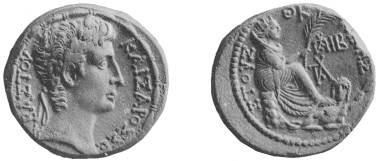
FIG. 343.
Female head.
ΒΑΛΑΝΕΩΝ CΥ[ριασ] Zeus seated
holding Nike. Date ‘104’ = B.C.
209/8.
Head of City. [Fox, Engr., ii. p. 30.]
ΒΑΛΑΝΕΩΤΩΝ CΥ Nike standing.
Date ‘104’ = B.C. 209/8.
Bust of Tyche of Seleuceia.
ΣΕΛΕΥΚΕΩΝ ΤΗΣ ΙΕΡΑΣ ΚΑΙ
ΑΥΤΟΝΟΜΟΥ Thunderbolt (with
fillet attached) on cushion placed on
stool.
Id.
ΣΕΛΕΥΚΕΩΝ ΤΗΣ ΑΥΤΟΝΟΜΟΥ
Thunderbolt.
Head of Zeus. [Z. f. N., iii. 350.]
ΣΕΛΕΥΚΕΩΝ ΤΗΣ ΑΥΤΟΝΟΜΟΥ
Thunderbolt. VI. Coele-Syria
Coele-Syria, in its more restricted sense, comprised the small tract
between Mounts Lebanon and Antilibanus; but in a more general way
the name was applied to all the country east and south-east of the latter
range of mountains.
Head of Zeus, laur.
ΠΤΟΛΕΜΑΙΟΥ ΤΕΤΡΑΡΧΟΥ Eagle
flying.
Id.
ΠΤΟΛΕΜΑΙΟΥ ΤΕΤΡΑΡΧΟΥ ΚΑΙ
ΑΡΧΙΙΕΡ (sic) Two warriors stand-
ing facing, holding spears; laurel-
wreath.
Head of Lysanias, diademed.
ΛΥΣΑΝΙΟΥ ΤΕΤΡΑΡΧΟΥ ΚΑΙ ΑΡ-
ΧΙΕΡΕΩΣ Athena Nikephoros stand-
ing.
Head of Octavian.
ΖΗΝΟΔΩΡΟΥ ΤΕΤΡΑΡΧΟΥ ΚΑΙ
ΑΡΧΙΕΡΕΩΣ Head of Zenodorus.
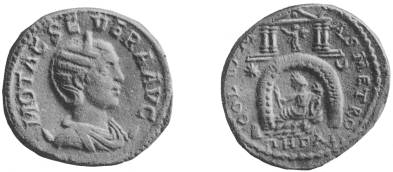
FIG. 344.
Pl. XI. 3); Ram standing; Shrine of the Tyche, and two female figures
each supporting a cage containing a cock; Doe suckling child (see
Rossbach in Neue Jahrb., vii. 395); Horse and bull facing, between
them, cypress; Maenad (?) holding vine-branch (De Saulcy, p. 52,
No. 10; Rev. Num., 1844, p. 14). Games, CЄΒΑCΜΙΑ (Clermont-Gan-
neau in Rec. d'Arch. d'Orient, Aug. 1901), ΟΛΥΜΠΙΑ, ΑΓΙΑ ΙЄΡΑ
CЄΒΑCΜΙΑ. Dates. On coins of the earlier emperors dates of the
Seleucid era occur.
VII. Trachonitis
VIII. Decapolis
IX. Phoenicia
[Hill, Brit. Mus. Cat., Phoenicia, 1910; Babelon, Les Perses Achéménides ... et Phénicie,
1893; Rouvier, Numismatique des Villes de la Phénicie (Journal Intern. d'Archëologie Numism.,
iii-vii (1900-1904).
מא (‘ex Arado’). Phoenician fish-god,
holding dolphin in each hand.
Galley with sea-horse beneath [Babe-
lon, Perses Ach., Pl. XXII. 1, &c.]
מא Half-figure of fish-god.
Prow with dolphin beneath [Ibid., Pl.
XXII. 7, &c.].
Head of Melkart laureate, of archaic
style. [Babelon, No. 878.]
מא Galley on waves.
Id. [Babelon, Pl. XXII. 12 f.]
Id. 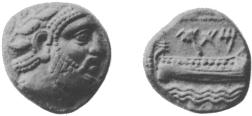
FIG. 345.
Head of Melkart.
[Bouvier, Villes de Phénicie, No. 106.]עב (‘Abdastart). Galley.
![]() (B. M. Guide, Pl. XXVII. 3, 4). Some
of these are dated by the era of the conquest of Phoenicia (B.C. 333/2).
They probably ceased with the reign of Antiochus I (B.C. 281-261), on
some of whose tetradrachms the same monogram occurs. Probably to
the same period is to be assigned the Attic tetrobol with obv. Beardless
laureate head, rev. מא Prow (Babelon, Perses Ach., Pl. XXIII. 2).
(B. M. Guide, Pl. XXVII. 3, 4). Some
of these are dated by the era of the conquest of Phoenicia (B.C. 333/2).
They probably ceased with the reign of Antiochus I (B.C. 281-261), on
some of whose tetradrachms the same monogram occurs. Probably to
the same period is to be assigned the Attic tetrobol with obv. Beardless
laureate head, rev. מא Prow (Babelon, Perses Ach., Pl. XXIII. 2).
Head of Zeus or Melkart.
Prow with or without Athena as figure-
head.
Head of Tyche.
Prow.
Id.
Prow with or without Athena as figure-
head.
Id.
Stern of ship.
Head of Zeus.
Beak of ship.
Head of Poseidon, crowned with marine
plant. [Babelon, Pl. XXIII. 14.]
ΑΡΑΔΙΩΝ Zeus standing; symbol,
palm-tree; date=B.C. 174.
Bee, and dates = B.C. 174-110.
[See Ephesus, p. 575.]ΑΡΑΔΙΩΝ Stag and palm-tree.
Head of Zeus.
Beak of ship.
Head of Tyche.
Poseidon seated on prow.
Id.
Aplustre. 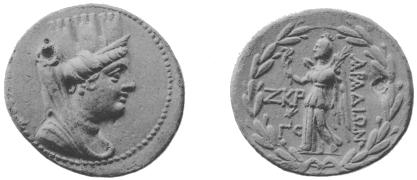
FIG. 346.
Head of Tyche, veiled and turreted
(Fig. 346).
ΑΡΑΔΙΩΝ Nike standing, holding
aplustre and palm; in field, Greek
date and Phoenician and Greek
letters.
Head of Zeus.
Prow with Athena as figure-head (B.C.
130-110).
Æ size .6
Head of Tyche.
Prow (B.C. 119-109).
Head of Gorgon.
Aplustre (B.C. 111, 110).
Head of Astarte veiled.
Humped bull (B.C. 96).
Id.
Id. (B.C. 94-21).
Head of Tyche.
Poseidon seated on prow.
Heads of Zeus and a goddess jugate.
Prow with Athena as figure-head (B.C.
137-52).
Head of Zeus.
Prow (B.C. 84-45).
Galley, with horse’s head as figure-
head, manned by three armed men;
beneath, hippocamp.
Vulture standing on an incuse ram.
Id.
[Babelon, Perses Ach., Pl. XXVI. 12.]Lion devouring a bull, of which the
head is in relief and the body incuse.
Inscr. in Phoenician letters לפעל מלך גבל (= Elpaal Melek Gebal).
Id. [Babelon. Perses Ach., Pl. XXVI.
20, &c.]
Lion devouring bull. Inscr. in Phoeni-
cian letters עזבעל מלך גבל (= Azbaal
Melek Gebal); עינאל מלך גבל (=
Ainel Melek Gebal); or גבלאדרמלך מלך
(= Adramelek Melek Gebal).
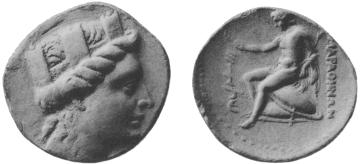
FIG. 347.
Head of the city, turreted (Fig. 347).
ΜΑΡΑΘΗΝΩΝ Marathos holding ap-
lustre and branch, seated on shields.
In front, Phoenician date 33 (= B.C.
226).
Head of Queen Berenice II (?), veiled.
ΜΑΡΑΘΗΝΩΝ Marathos standing
beside column, holding aplustre.
Phoenician date 34 (= B.C. 225) and
73.
Id.
מרת Asklepios-Eshmun, with serpent
staff. Dates 33 and 35.
Id.
מרת Marathos standing. Dates 40-
108.
Id.
Prow. Date 73.
Bust of Ptolemy VI as Hermes.
מרת Marathos standing. Dates 80-91.
Bust of Tyche.
Id. Dates 103-105.
Female bust, laureate.
מרת Nike. Dates 85-90.
Head of Zeus.
ΜΑΡΑ or no city-name. Double cor-
nucopiae. Phoenician dates 120-
168, Greek dates 236-375. 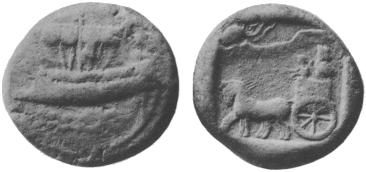
FIG. 348.
Galley with square-sail furled (Fig.
348).
Incuse square. King of Persia in chariot,
driven by charioteer; in field, fore-
part of wild goat, incuse.
Id.
Incuse square. King shooting; in field,
heads of goat and Hes, incuse.
Id.
Incuse square. King running, shooting.
Id.
Head of Bes.
Id., but sail triangular.
Incuse circle. King shooting.
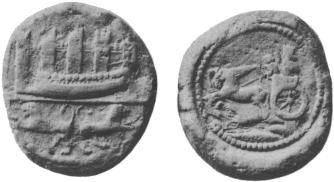
FIG. 349.
Galley before fortified wall of a city. In
exergue, two lions (Fig. 349).
Incuse circle. King in chariot, driven
at full speed by charioteer; beneath,
wild-goat, incuse.
Id.
Incuse square. King slaying lion with
sword.
(With letter ב on obverse or reverse).
Galley with rowers, at sea.
Incuse circle. King in chariot, driven
slowly by charioteer; behind him, an
attendant in Egyptian royal costume.
On one specimen the date 14.
Id.
Id. (without attendant).
Id.
King slaying lion.
Id.
King kneeling, shooting. 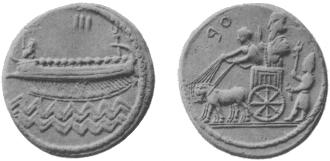
FIG. 350.
Galley with rowers, at sea. Dates 1—
13 (Fig. 350).
עב King in chariot, with Egyptian at-
tendant, as in preceding reign.
Id.
Id. (without attendant).
Id. (without dates) ב.
ע King slaying lion.
Id. (without dates).
King in chariot, driven by charioteer.
Id. (with dates 3-10).
King half-kneeling with spear and bow.
Head of a king (Strato I ?).
Galley. Dates 11, 12.
Galley with rowers, at sea. Dates 1-4.
תע King in chariot, as in preceding
reign, but with attendant in Asiatic
dress.
Id. (without dates).
תע King slaying lion. 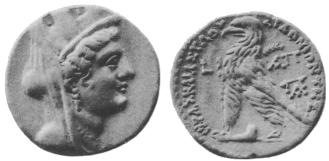
FIG. 351.
Head of City, turreted and veiled.
(Fig. 351.)
Eagle on prow of galley, palm over
shoulder.
AR Didrachm 108.3 grs.
Busts of the Dioskuri surmounted by
stars.
ΤΡΙΠΟΛΙΤΩΝ ΤΗΣ ΙΕΡΑΣ ΚΑΙ
ΑΥΤΟΝΟΜΟV. Tyche of City stand-
ing, holding tiller and cornucopiae;
the whole in wreath.
Dolphin swimming above waves; be-
neath, murex; illegible inscription.
Incuse square, within which Owl accom-
panied by crook and flail, Egyptian
symbols of royalty.
Id.; no inscription.
Similar type.
Dolphin, with or without murex.
„ 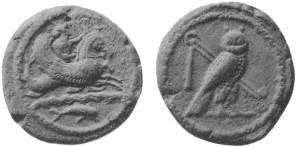
FIG. 352.
Melkart holding bow and riding over
the waves upon a sea-horse; beneath
waves, a dolphin.
Owl with crook and flail; Phoenician
letters or dates sometimes in the field
(Fig. 352).
Sea-horse and dolphin.
Similar type. 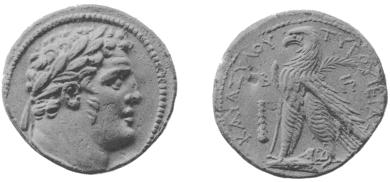
FIG. 353.
Head of the city turreted and veiled.
[Zeit. f. N., vi. 4.]ΤΥΡΟΥ ΙΕΡΑΣ ΚΑΙ ΑΣΥΛΟΥ Double
cornucopiae. Year 23.
Head of Melkart-Herakles, laureate.
(Fig. 353).
ΤΥΡΟΥ ΙΕΡΑΣ ΚΑΙ ΑΣΥΛΟΥ Eagle
on beak of ship. In field, dates and
symbol, a club.
AR 112 grs.UNCERTAIN COINS OF PHOENICIA.
King, wearing kidaris and kandys,
stabbing lion. [Macdonald, Hunter
Cat., iii. p. 273, Pl. lxxvii. 17.]
בענא (Baana) Cow suckling calf; dotted
incuse square.
Melkart holding up lion by tail and
striking at it with club.
Similar, but monogram instead of in-
scription. [Babelon, Perses Ach., No.
318, Pl. VIII. 1.].
Cow suckling calf.
[Macdonald, op. cit., Pl. lxxvii. 15.]Melkart (as on obverse of preceding);
incuse square.
Sea-god, with bearded head, body ter-
minating in fish-tail; in r. trident,
in l. wreath.
אז (Az?) Lion at bay on rocky ground.
[Babelon, loc. cit., No. 320, Pl. VIII.
3]. X. Galilaea
[De Saulcy, Numismatique de la Terre-Sainte (1874).]
XI. Samaria
[De Saulcy, Numismatique de la Terre-Sainte (1874).]
XII. Judaea
[De Saulcy, Numismatique de la Terre-Sainte (1874).]
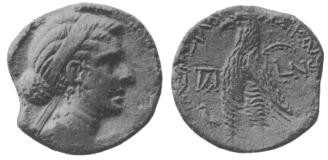
FIG. 354.
Janiform diademed male and female
heads, or head of Athena as on coins
of Athens.
עזה in Phoenician characters, Owl in
incuse square, sometimes before the
fortified wall of a city.
Id.
עז Forepart of horse; incuse square.
Id.
ΑΘΕ Head of Athena; incuse square.
Head of Athena.
עז Owl facing; incuse square.
Female head.
Head of Seilenos facing; incuse square.
Similar.
Bust of Bes facing; incuse square.
Bearded helmeted head. [Brit. Mus.;
Pilcher, Proc. Soc. Bibl. Arch., 1908,
pp. 45 f.]
יהו in Phoenician characters, Jahveh
seated on car with winged wheel.
Kings, Princes, and Roman Procurators of Judaea
[See especially Madden, Coins of the Jews, 1881; Kennedy in Hastings Dict. of the Bible,
art. ‘Money’ (1900); Th. Reinach, Jewish Coins, 1903.]
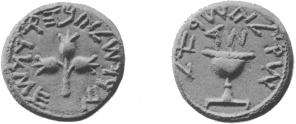
FIG. 355.
שקל ישראל (Shekel Israel), Cup or
chalice, above which א, ב, ג, or ד
(numerals 1 to 4), referring to the
official years of Simon’s rule corre-
sponding to B.C. 139-136. On the
coins of years 2-4 the numeral is
preceded by ש (for Shenath, year).
ירושלם קדשה (Jerushalem Kedoshah), or
ירושלים הקדושה (Jerushalaim ha-kedo-
shah), ‘Jerusalem the Holy,’ Branch
with three buds (Fig. 355)
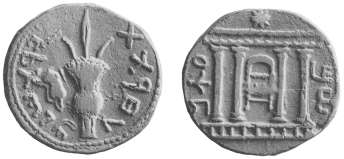
FIG. 356.